 He was a good husband at first. Then he turned into a total ape. 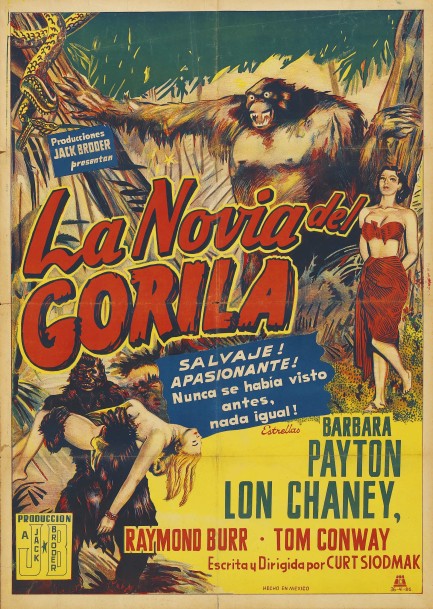
This Mexican poster for La novia del gorilla, aka Bride of the Gorilla, is chockful of interesting elements, from the massive simian at top, to the snake hanging in a tree, to star Barbara Payton being borne away by a second gorilla, and co-star Carol Varga in her classic “native” two-piece. There's a line early on: “White people shouldn't live too long in the jungle. It brings out their bad side—jealousies, impatience.” That sums up the thrust of the plot, the subplot, and the underlying themes, because it's a one-note psychological suspense flick about northerners out of place in the humid global south.
In brief, Raymond Burr runs a rubber plantation for colonial boss Paul Cavanaugh, and has the hots for his wife Barbara Payton. He kills Cavanaugh, thanks to a serendipitous lethal snake that's slithering by. He gets away with the murder, but he can't fool the withered old crone who runs the plantation house. She uses the pe de guine—the so-called plant of evil—to place a curse on Burr. It's slow to act, but by the time he marries the widowed Payton he comes to think he's changing into a beast. Is it in his mind? Is he suffering the effects of slow poisoning from the pe de guine? Or is he really a monster?
Bride of the Gorilla, while a middling and basically inconsequential cinematic effort, is well remembered by Hollywood buffs for its extracurriculars. Barbara Payton was being surveilled via detective by her husband Franchot Tone, and passed on the unfortunate news that Payton was enjoying sweaty horizontal interludes with Woody Strode. He was one of the best looking guys you can imagine, so it's no wonder the highly sexed Payton got hot and bothered. It was one in a series of affairs for her, but this one harmed her career because Strode was black. She would later suffer one of the more infamous downward spirals in celebrity history.
In any case, the question is should whether you give Bride of the Gorilla a screening. Hmm... well, owing to the good cast, we think so. Chaney and Burr are quality talents even when overrmatched by substandard screenwriting, and Payton had been an acclaimed actress in earlier roles and is certainly decent here. But keep your expectations in check. It's watchable, but it's still pure b-movie schlock. It was originally released in the U.S., and opened in Mexico today in 1951 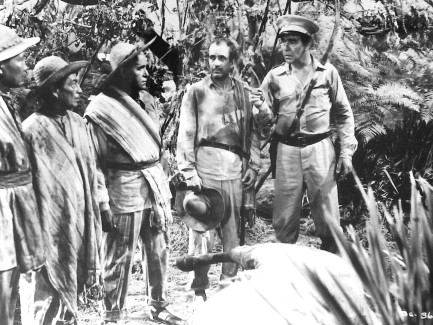 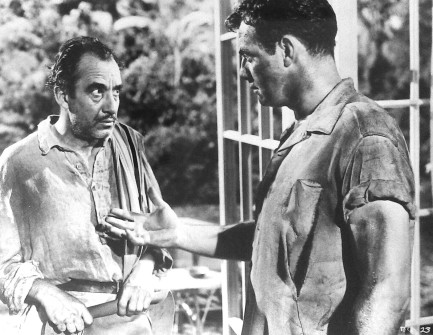 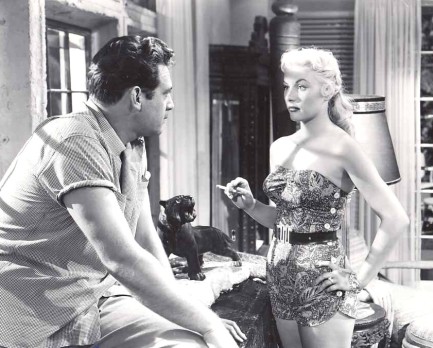 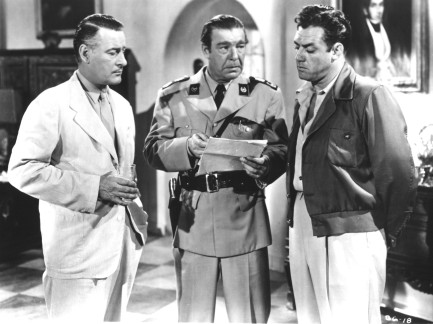 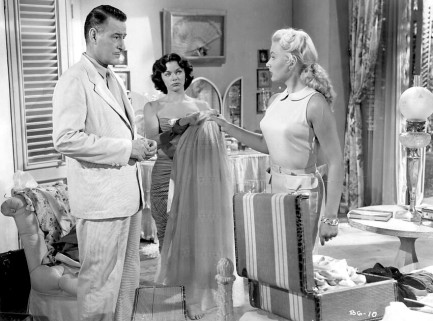 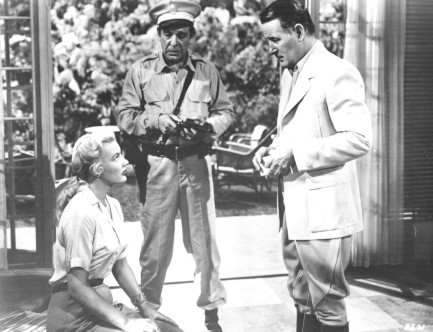 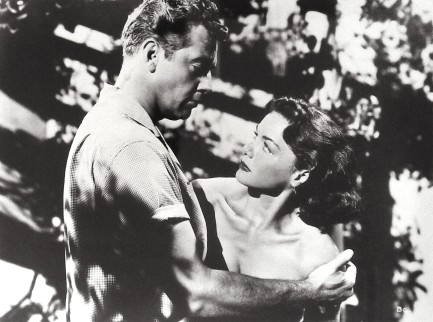 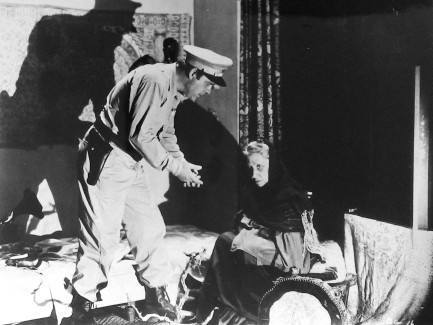 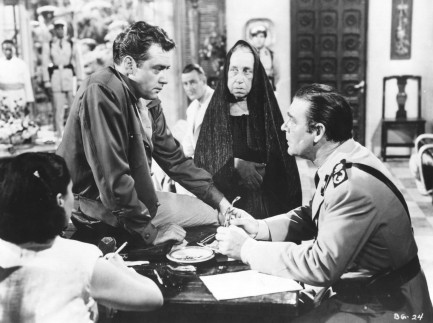 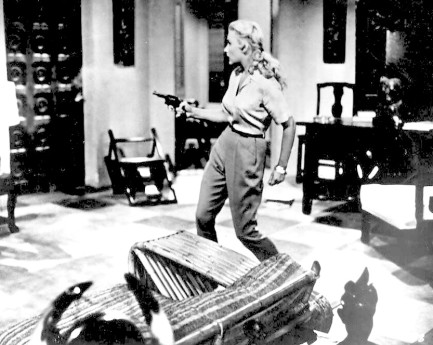 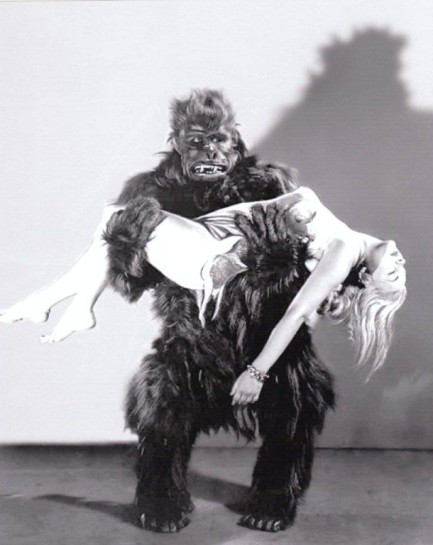
 B-movie actor generates A-list headlines for all the wrong reasons.
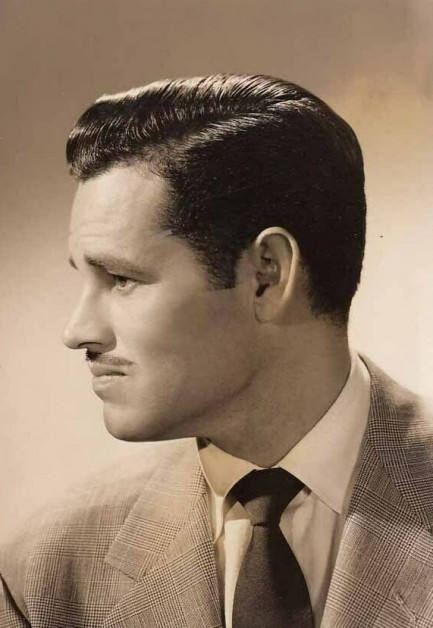 Show business careers go off the rails for a wide array of reasons—lack of talent, lack of audience appeal, substance abuse, and a predilection for general mayhem all come to mind. Hollywood actor Tom Neal fits legendarily into the last category. From his debut in 1938 through 1951 he logged more than seventy film appearances. That's incredible output by any measure. Most of his roles were in b-movies, but there were some notable parts mixed in. His career highlights included Another Thin Man, the film noir Detour, and Crime, Inc. Show business careers go off the rails for a wide array of reasons—lack of talent, lack of audience appeal, substance abuse, and a predilection for general mayhem all come to mind. Hollywood actor Tom Neal fits legendarily into the last category. From his debut in 1938 through 1951 he logged more than seventy film appearances. That's incredible output by any measure. Most of his roles were in b-movies, but there were some notable parts mixed in. His career highlights included Another Thin Man, the film noir Detour, and Crime, Inc.
Neal caused minor scandals early in his career, but he graduated to the majors beginning in early 1951, when he met tempestuous actress Barbara Payton and the two began dating. Payton had announced her engagement the previous year to debonair leading man Franchot Tone, but her ideas about commitment weren't of the standard variety. She was still married to an Air Force Captain named John Payton while dating Tone, and had allegedly slept with Gary Cooper and Steve Cochran while working with them on the 1950 western Dallas. When Neal met her, she kicked Tone to the curb and announced she and Neal would be marrying. But Payton was fickle, to say the least, and ended up dropping Neal and getting re-engaged to Tone. All this while still married to her Air Force guy.
One thing Hollywood people can count on is crossing paths with their colleagues at one point or another—especially if they're dating the same woman. When Neal crossed paths with Tone and Payton in September 1951 at her apartment, he intended to punish the man who had won Payton's hand. Everyone in Hollywood knew Neal had been an amateur boxer. Maybe the qualifier “amateur” gave Tone excessive confidence. Maybe he didn't know that Neal, who you see below with barbells overhead and a tube sock in his shorts, had accumulated a 31-3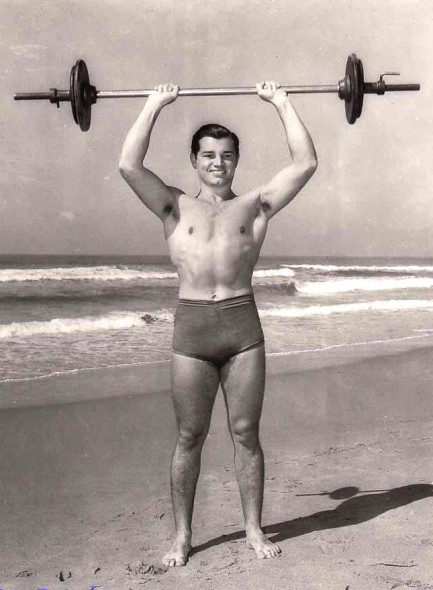 record in the ring. Maybe Tone slipped on a dollop of Beluga caviar. Payton said Tone simply had no choice about fighting because Neal attacked him. Whatever the reason, Neal floored Tone with his first punch, and continued to beat him afterward, delivering cheek and nose fractures. Tone lay in an eighteen hour coma in the hospital. Ironically, that was the day Payton's divorce had come through. record in the ring. Maybe Tone slipped on a dollop of Beluga caviar. Payton said Tone simply had no choice about fighting because Neal attacked him. Whatever the reason, Neal floored Tone with his first punch, and continued to beat him afterward, delivering cheek and nose fractures. Tone lay in an eighteen hour coma in the hospital. Ironically, that was the day Payton's divorce had come through.
1951 had been a pretty good year for Neal up to that point. But from then onward he was Hollywood persona non grata. He'd had more roles in ’51 than he would the entire rest of his career. We wouldn't go so far as saying that means Tone had the last laugh, since it would have been a extraordinarily painful laugh, considering the injuries and cosmetic surgery that followed. But okay, in that karmic way that's never fully satisfying, Tone at least must have felt a bit of Schadenfreude. Neal was blacklisted, and Payton was his. The good times didn't last. He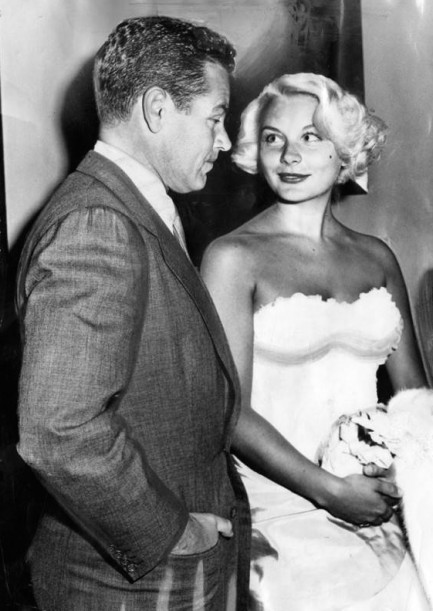 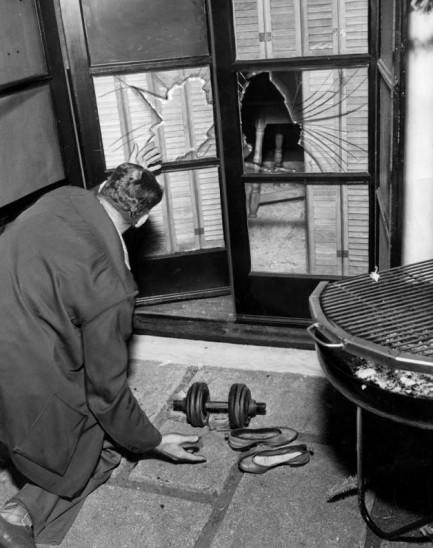 soon discovered that Payton—wait for it—had never stopped seeing Neal, including while Tone was in the hospital with a broken face. So there went that marriage. It seemed as if Neal had unequivocally won Payton's affections after all, and she does look happy in the 1952 photo above, but it's probably no surprise to learn that the two parted ways after a few tumultuous years, some broken windows, and at least one police intervention. Payton went on to have truly epic problems that would put a South American novela to shame. soon discovered that Payton—wait for it—had never stopped seeing Neal, including while Tone was in the hospital with a broken face. So there went that marriage. It seemed as if Neal had unequivocally won Payton's affections after all, and she does look happy in the 1952 photo above, but it's probably no surprise to learn that the two parted ways after a few tumultuous years, some broken windows, and at least one police intervention. Payton went on to have truly epic problems that would put a South American novela to shame.
Neal nursed his severely damaged career along, landing only occasional minor parts, and by the time the ’60s rolled around couldn't beg, barter, or buy a role. He had been married for a few years during the late ’50s, and in 1960 he married again, to a receptionist named Gale (sometimes Gail) Bennett, who you see below. In April 1965 police were summoned to Neal's home in Palm Springs where they found Bennett dead. She had been shot through the back of the head with .45 calibre pistol, the 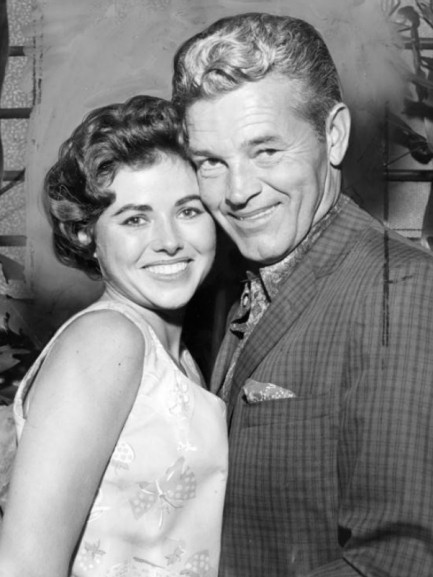 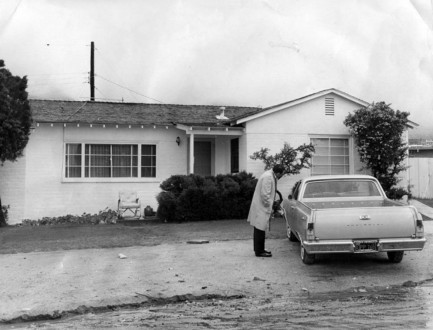 slug entering her skull behind her right ear and ending up in a sofa cushion. Neal wasn't on the premises when police arrived, but was soon arrested, and claimed the shooting had been an accident, the result of a struggle over the gun after his wife pulled it on him. slug entering her skull behind her right ear and ending up in a sofa cushion. Neal wasn't on the premises when police arrived, but was soon arrested, and claimed the shooting had been an accident, the result of a struggle over the gun after his wife pulled it on him.
Accounts of the killing vary, as they always do. In some, Neal shot Bennett as she was taking a nap. In others, they argued. We even found one that said Neal claimed the accident occurred while he and Bennett were making love. At trial Neal's defense attorney claimed a mystery man had pulled the trigger. We were struck, however, when we found that Bennett had secretly filed for divorce, and in the filing specifically mentioned Neal threatening her with a .45 automatic. If that detail struck us, it certainly must have made an impact on the jury. In the end, after a sensational trial, the dozen jurors convicted Neal of involuntary manslaughter.
Neal spent only six years behind bars before being paroled. That's a pretty sweet deal for what many suspected was a clearcut case of premeditated murder. Also, note that during the dust-up with Tone, one witness said Neal threw more than thirty punches after Tone was down. That could be construed as attempted murder, were you inclined to put a label on it, and if that was the plan it almost worked. Doctors thought for a while Tone would never awaken. Neal was a rough and tumble fellow, there's little doubt. But looks and a bit of charm will carry you a long way in life. Eventually, though, even those can run dry. Neal died eight months after his release from prison, aged fifty-eight, of heart failure, looking a shell of his former self.
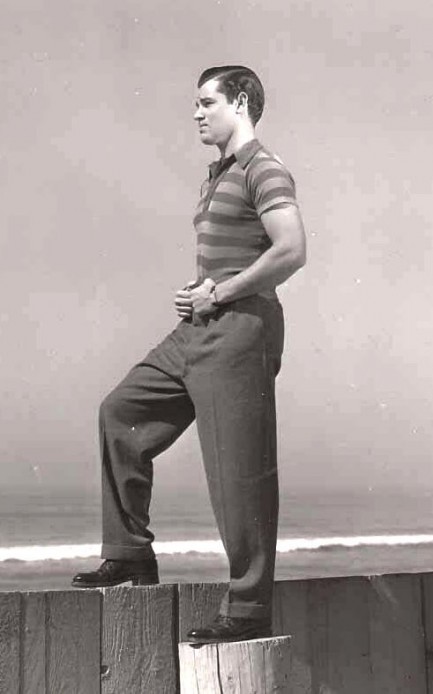 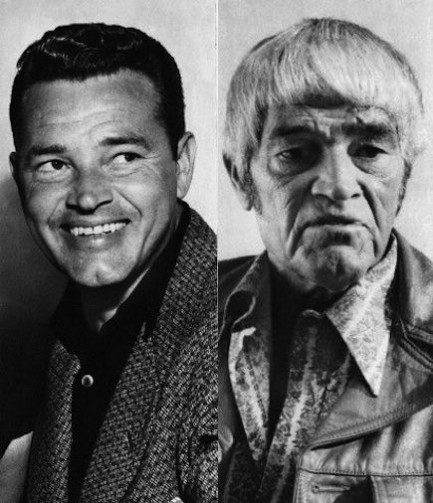
 A Trapped criminal always fights to the death. 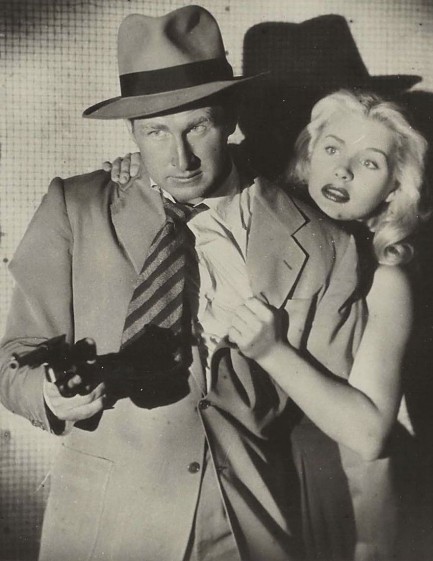 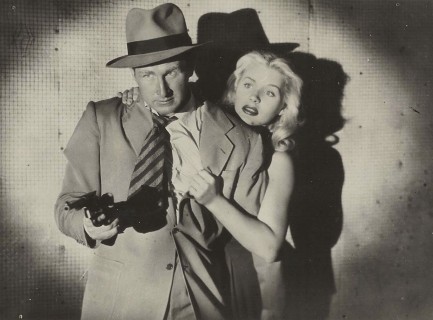
Above you see a crop and full frame version of one of the greatest film noir promo photos ever made, in our opinion, from the 1949 thriller Trapped. Lloyd Bridges stars as a counterfeiter stalked by treasury agents, and Barbara Payton co-stars as his loyal lady love. We may talk about this film at some point. Payton would later earn her place in Hollywood lore by spiraling down the drain of drugs and vice. We discussed that in detail several years ago, and it's a very noir tale that you can check out at this link.
 Nightbeat shines a light into the darkest reaches of American vice. 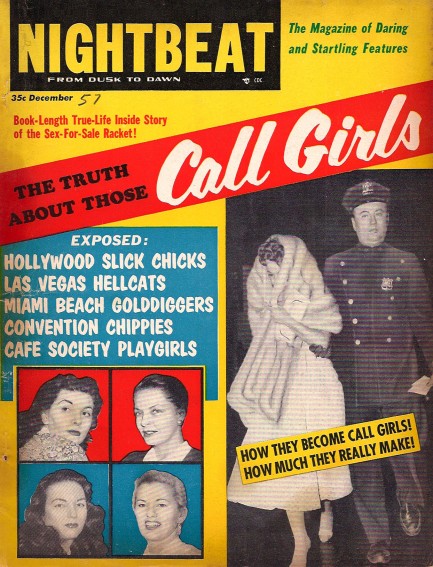
This issue of Nightbeat which hit newsstands in December 1957 is the first ever published—and possibly the last. We've seen no hint of another one. That would make it probably both the best debut and finale by any mid-century tabloid. The magazine focuses entirely on call girls, delving into their activities in cities such as Washington, D.C., Hollywood, and Miami Beach. Shame is the name of the game here—there are many photos of arrested prostitutes hiding from the camera, many actual names revealed, and in the Hollywood section many of those names belong to celebrities.
Among the major and minor stars covered are Ronnie Quillen, an actress-turned-hooker-turned madame, who after years in the trade was beaten to death in 1962. Patricia Ward, aka The Golden Girl of Vice, makes an appearance. She was turned out by her boyfriend Minot Jelke, who was heir to a margarine fortune but had fallen on hard times and decided he needed to use his girlfriend'a body to survive. Actress Lila Leeds is covered. She's best known today for being the other party snared in Robert Mitchum's drug bust. Most sources today don't mention that she went on to be arrested in Chicago for soliciting.
The magazine also touches on Barbara Payton. Back in 1957 it was already known that she sold her wares, but she's unique in that we now know what it was like to have sex with her, thanks to Scotty Bowers, who revealed in his 2012 Flickertown tell-all Full Service that for a while Payton was the top call girl in town, and added this tidbit: “I have to say that a half hour with her was like two hours with someone else. She was electrifyingly sexy and made a man feel totally and wholly satisfied.” for a while Payton was the top call girl in town, and added this tidbit: “I have to say that a half hour with her was like two hours with someone else. She was electrifyingly sexy and made a man feel totally and wholly satisfied.”
The details keep coming for more than sixty pages in Nightbeat. One unlikely character is Lois Evans Radziwill, née Lois Olson, who is better known as Princess Radziwill. Info on her is actually a bit scarce, especially considering she was a princess. She was born in North Dakota, sprouted into a six-foot beauty, and married Polish royal Prince Wladislaw Radziwill in 1950. By 1951 she was divorced and running with the Los Angeles fast set. Nightbeat says she was arrested under suspicious circumstances—check the photo at right—but we can find no official confirmation of that anywhere.
However, according to a couple of non-official sources she became addicted to drugs, pawned most of her possessions, and eventually turned to prostitution in New York City, selling herself on the streets of Harlem—at least according to one account. We'll stress here that these are third party claims from blogs and we're merely collating and reporting them. We make no assertions as to their accuracy or truthfulness. In fact, let's just say they're all lying. We don't want to get sued again. Did we mention Pulp Intl. got sued a while back? That's when you know you've really arrived. We kind of thought being based way out in the Philippines would discourage that sort of thing—but no. We'll get into that some other time maybe.
Anyway, Nightbeat is an amazing magazine. It's possible there was never another issue put together. The first one would have been such a tough act to follow. But the masthead designation Vol. 1 issue 1 seems to indicate others were planned, so maybe there are more out there somewhere. This was really a great find for us. It's going for fifty dollars on Ebay right now, but we got ours for five as part of a group of ten other excellent magazines, including this one. We intend to hold onto Nightbeat for a long time. It's a dirty treasure. We have nineteen interior scans below. 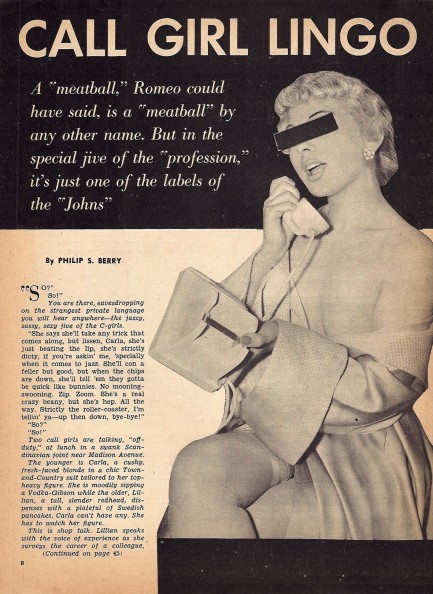 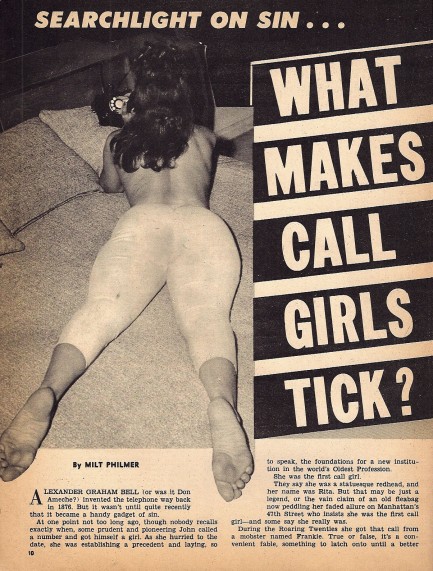 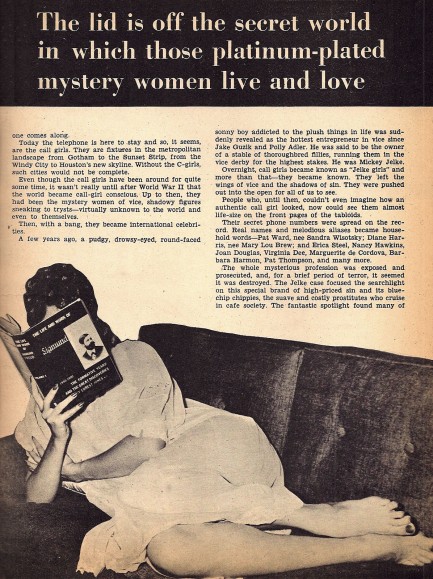 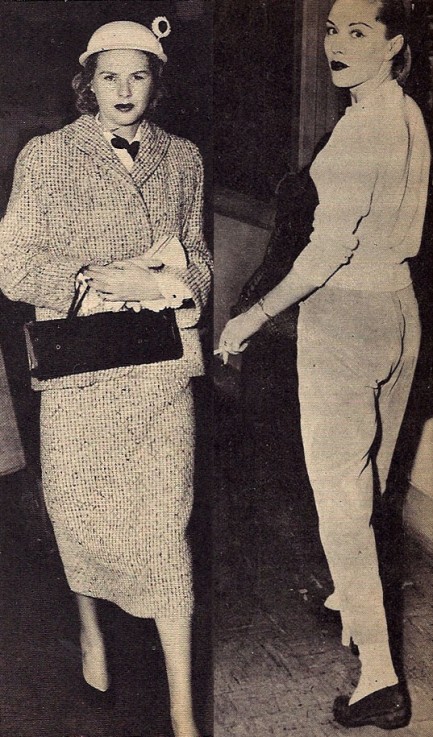 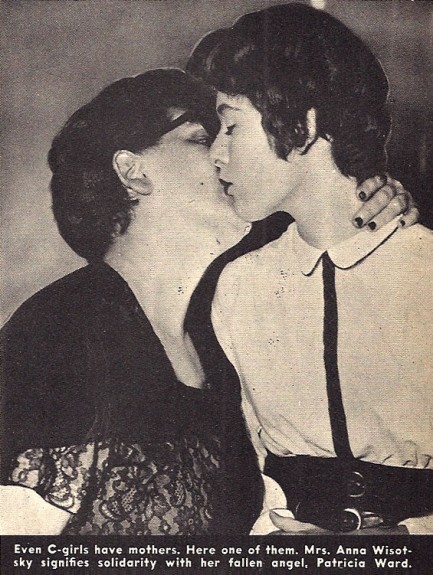 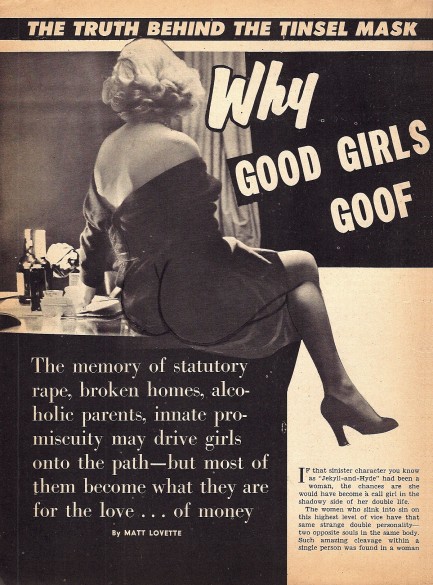 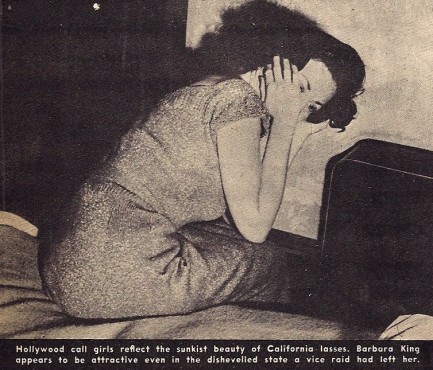 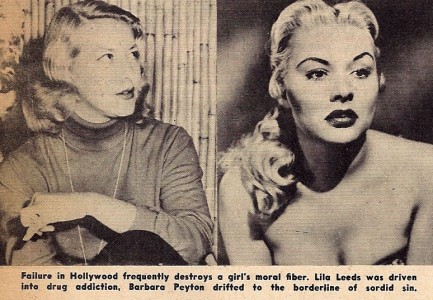 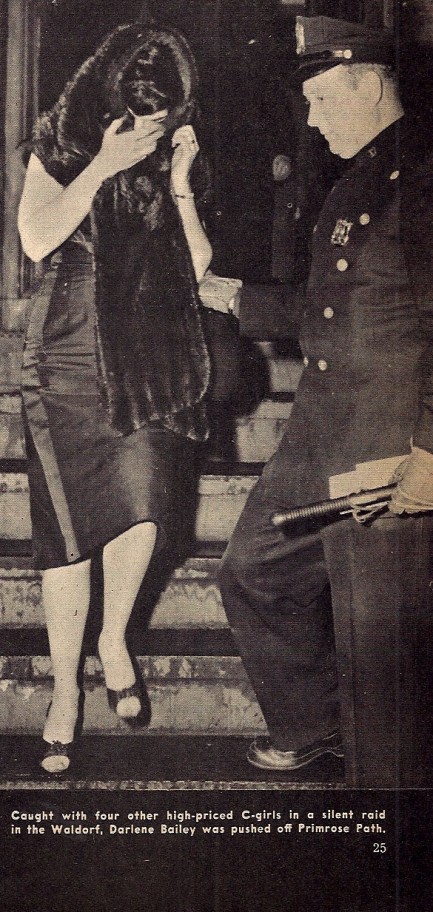 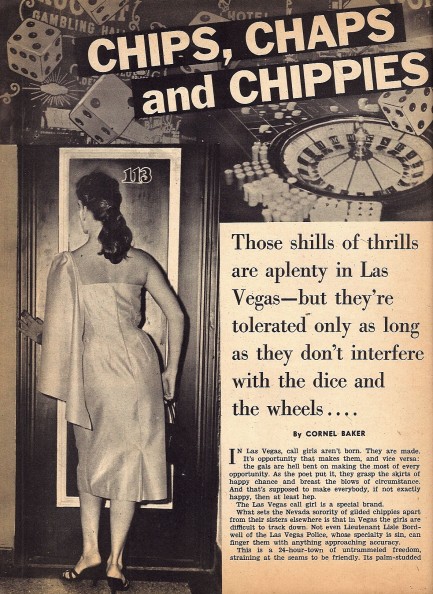 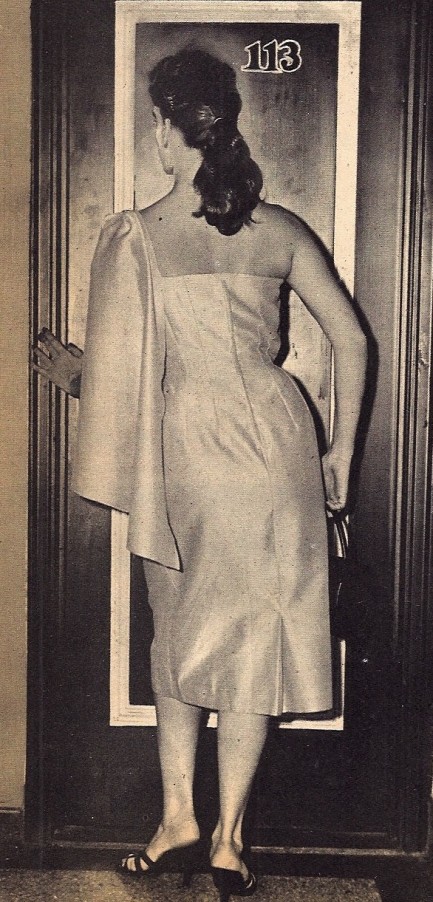 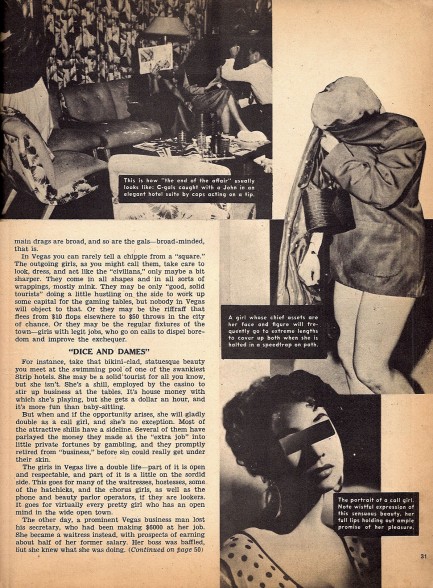 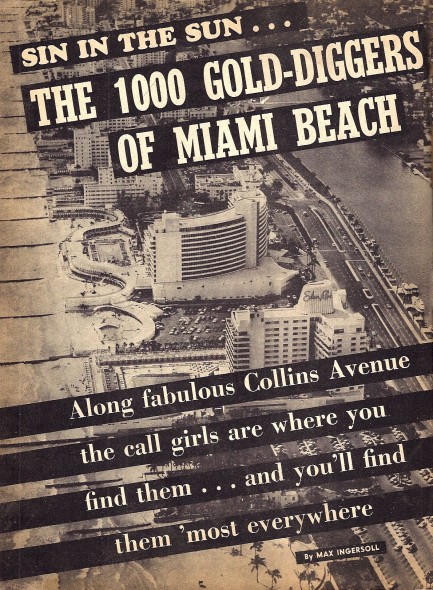 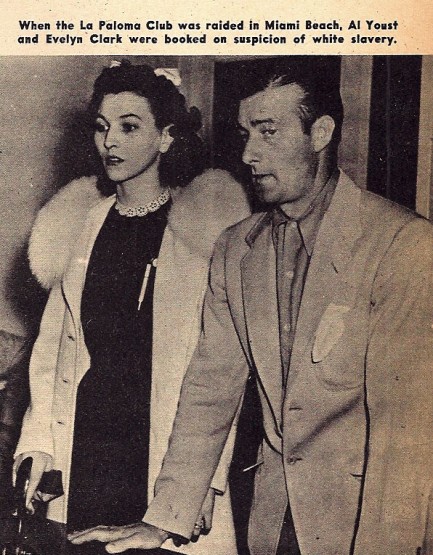 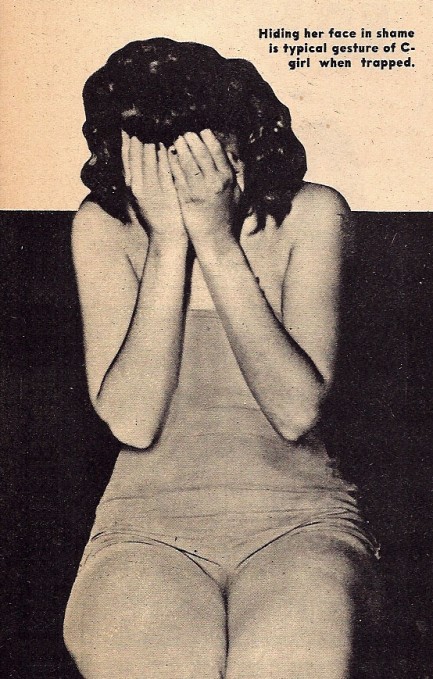 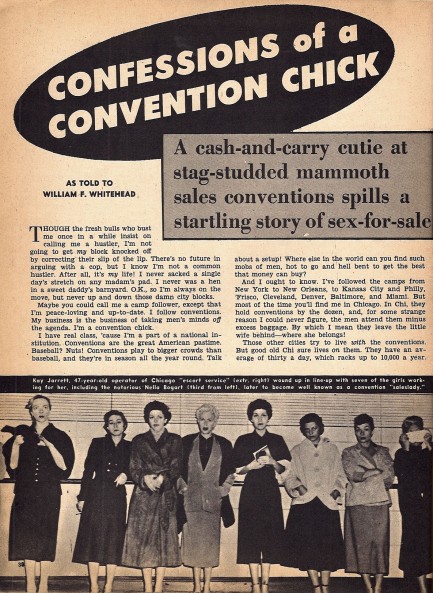 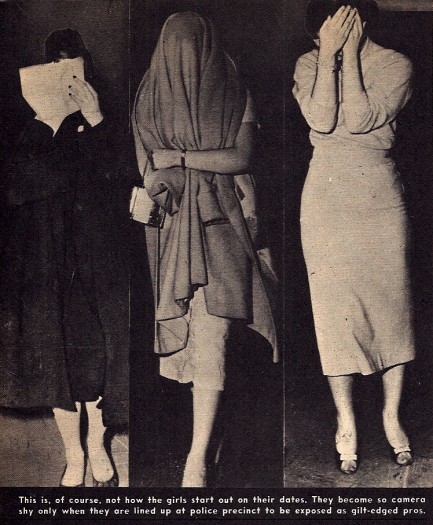 
 Did she or didn’t she?  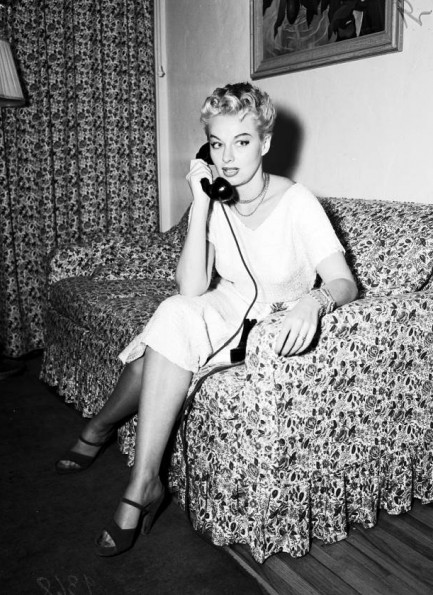
These two photos showing burlesque dancer Lili St. Cyr were shot today in 1951 for a Los Angeles Examiner story about St. Cyr’s legal difficulties. On 23 February of that year she had begun performing at Ciro’s supper club in Hollywood. It was a different type of club for her—it lacked the intimacy of her normal venues, and would sap some of the heat from her act, but the place was world famous and considered by the smart set to be classy. It had hosted Edith Piaf, Marlene Dietrich, Duke Ellington, and Dinah Washington. Of late it was facing stiff competition from Macambo’s, a Brazilian themed joint across the street, and owner Herman Hover wanted to make a splash with St. Cyr. He spent thousands refurbishing the stage just for her, and she would be the first burlesque dancer to transition from men’s clubs to L.A.’s most famous supper club. On premiere night celebs such as Ronald Reagan, Nancy Davis, Franchot Tone, Barbara Payton, Lex Barker, Mickey Rooney, and Los Angeles mayor Fletcher Bowron watched her strip down to toned perfection as they ate dinner and sipped drinks. Other celebs that visited that summer included Bette Davis, Humphrey Bogart, and Clark Gable. During St. Cyr’s residency she varied her act, but a standard bit was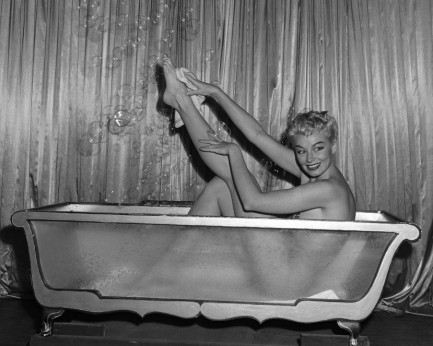 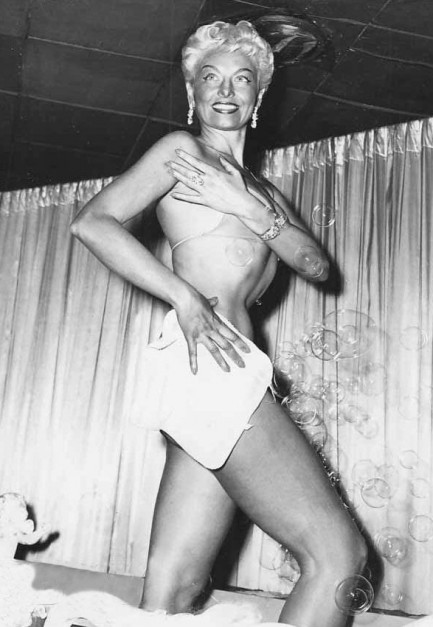 entitled "An Interlude Before Evening," and involved being helped from her clothing by her maid Sadie before slipping nude into a bathtub. But the nudity was an illusion, the cleverest part of her act, achieved through a combination of lighting, positioning, flesh-colored underwear, and sheer athleticism as she slipped quickly from behind a towel and into the sudsy tub. entitled "An Interlude Before Evening," and involved being helped from her clothing by her maid Sadie before slipping nude into a bathtub. But the nudity was an illusion, the cleverest part of her act, achieved through a combination of lighting, positioning, flesh-colored underwear, and sheer athleticism as she slipped quickly from behind a towel and into the sudsy tub. On 18 October a group of Los Angeles sheriff’s deputies, who were trying to enforce a countywide ban against stripping, arrested St. Cyr and Herman Hover. The charges were the usual slate. St. Cyr called upon celebrity lawyer Jerry Giesler—an event the two Examiner photos at top are supposed to be illustrating—and Giesler proceeded to help turn what was already a media boon for St. Cyr into a full bonanza. Giesler was a showman, and he loved cases that had the potential to increase his fame. He made assorted sensational statements to the press, including one in which he promised to have his client perform her bath routine in the courtroom, and another in which he opined that putting together a jury of peers required empaneling a dozen strippers. He described St. Cyr as merely trying to improve her station in life, just an industrious woman trying to carve herself a piece of American pie. The press ate it up. 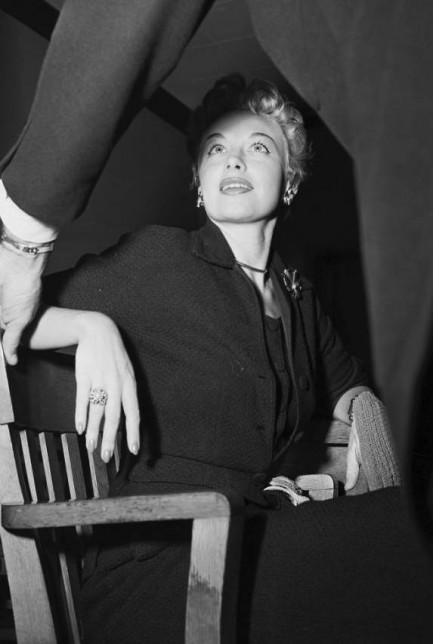 The trial was scheduled for early December in the Beverly Hills Courthouse. Giesler kept the jury—which wasn’t all strippers, but at least was mostly female—laughing with his continual antics. He introduced St. Cyr’s rhinestone encrusted bra and g-string as people’s exhibits A and B. He drew diagrams on a blackboard illustrating how different observers' vantage points toward the stage were blocked by St. Cyr's maid. He flustered police officials by making them discuss in detail such such terms as “bump,” “grind,” and “half-bump,” and followed that up by putting Herman Hover on the witness stand and having him demonstrate those moves. The sight of the portly Hover attempting burlesque sent ripples of laughter through the courtroom. Years later Giesler wrote: “I can honestly say I succeeded in having her case laughed into a not-guilty verdict.” The trial was scheduled for early December in the Beverly Hills Courthouse. Giesler kept the jury—which wasn’t all strippers, but at least was mostly female—laughing with his continual antics. He introduced St. Cyr’s rhinestone encrusted bra and g-string as people’s exhibits A and B. He drew diagrams on a blackboard illustrating how different observers' vantage points toward the stage were blocked by St. Cyr's maid. He flustered police officials by making them discuss in detail such such terms as “bump,” “grind,” and “half-bump,” and followed that up by putting Herman Hover on the witness stand and having him demonstrate those moves. The sight of the portly Hover attempting burlesque sent ripples of laughter through the courtroom. Years later Giesler wrote: “I can honestly say I succeeded in having her case laughed into a not-guilty verdict.” That may have been true, but St Cyr’s icy demeanor was also an important factor. The women found her elegant and remote—the opposite of what they had expected. And the cops did their part for St. Cyr's defense by being terrible witnesses. One claimed that she emerged from the tub completely nude (the normal conclusion to her Interlude, and just as illusory). Another said she wore undies but that he could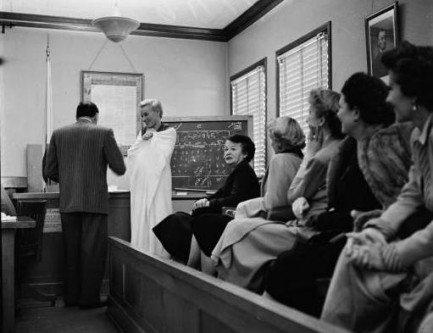 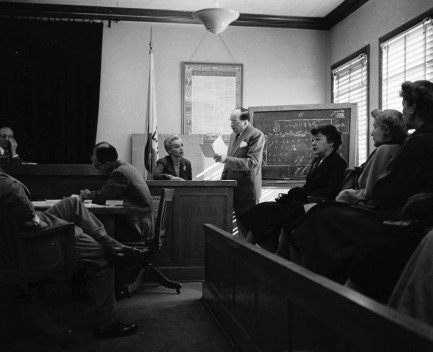 see the outline of her “private parts,” which he discerned in enough detail to determine “were shaven.” The inconsistencies were epic. Some said she caressed herself, others weren’t sure. Another described her towel as “about twenty, twenty-four inches.” In reality it was three times that size. It was as if St. Cyr's dance had dumbfounded the cops. see the outline of her “private parts,” which he discerned in enough detail to determine “were shaven.” The inconsistencies were epic. Some said she caressed herself, others weren’t sure. Another described her towel as “about twenty, twenty-four inches.” In reality it was three times that size. It was as if St. Cyr's dance had dumbfounded the cops. The confusion has extended even to the present day. For a performance that lasted barely fifteen minutes, it has had an amazing amount of conflicting information attached to it. Columnist Army Archerd claimed St. Cyr was indeed nude that night (clearly wrong, according to multiple testimonies); Sheila Weller’s book Dancing at Ciro’s claims an “all-male” jury (it was mostly female) was taken to Ciro’s to see the act (Giesler tried, but the judge said no); some sources claim St. Cyr performed a reverse strip, beginning nude in the tub and emerging to be slowly dressed by her maid (indeed, that was an oft-performed variation, so it is certainly possible it happened that night). Who's right, and who's wrong? Short of using a time machine to return to October 1951 there's no way to tell. At the end of the six-day trial the jury acquitted St. Cyr following a mere seventy-eight minutes of deliberations. There had been no indecent exposure. At least not that night. All St. Cyr’s biographers agree on this much—she was shy and regal offstage, but her performances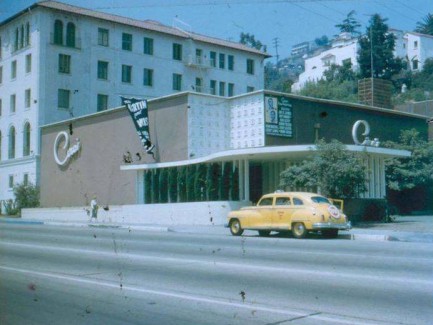 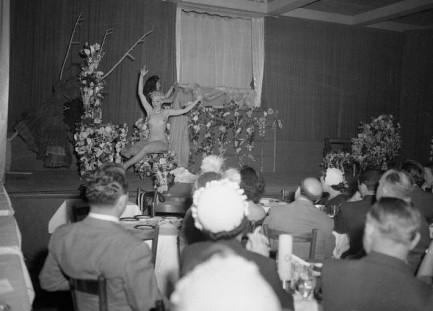 freed her to inhabit different characters. Despite her assertions that she always wore at least a g-string and bra, she definitely performed topless on occasion, as shown by the above photo taken at Ciro’s during early 1951. freed her to inhabit different characters. Despite her assertions that she always wore at least a g-string and bra, she definitely performed topless on occasion, as shown by the above photo taken at Ciro’s during early 1951. Sheriff’s deputies had gone to the club already intent upon arresting her based on what they had heard about the act, which may have influenced their testimony—i.e., they didn’t see her nude, but knew she had done it before. St. Cyr admitted in court she knew police were in the audience, thus she was especially careful that night. But what of other nights? Maybe Army Archerd did what columnists do—took an event he witnessed on one night and pretended it happened on a more useful one. Maybe St. Cyr, on occasions when she knew the cops were far away, flashed her audience to generate buzz. It’s likely we’ll never know what really happened, but that merely adds to the St. Cyr mystique. Did she or didn’t she? Only her maid knew for sure.
 No matter how far she ran dissatisfaction followed close behind. 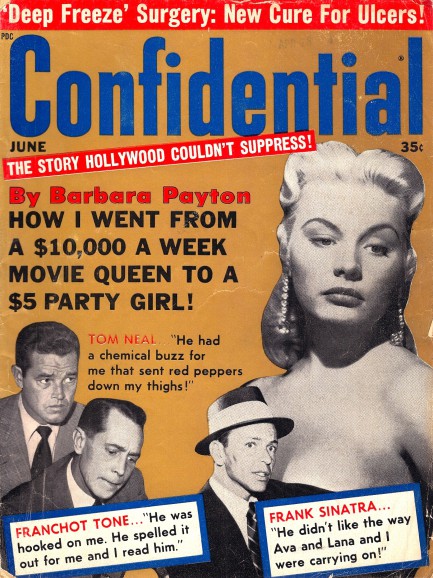
This gold colored June 1963 cover for Confidential magazine is entirely given over to actress Barbara Payton, whose self-penned hard-luck story appears inside and details her life troubles. The tale is well known and is one we’ve touched upon before—early marriage and early motherhood, followed by stardom, romances, and riches, followed by booze, drugs, divorces and crime. Confidential being Confidential, the editors neglect to mention that the story here is not an exclusive, but rather is excerpted from I Am Not Ashamed, Payton’s painfully revealing autobiography. I Am Not Ashamed did not sell especially well, and was pretty much forgotten a few years after its release. But it reappeared by chance two decades later when Jack Nicholson famously lent a rare copy to Jessica Lange to help her prepare for her femme fatale role in The Postman Always Rings Twice. Today the book is widely available. Just a few seconds reading Payton’s words conjures the suspicion she had a ghostwriter, and indeed, it was the king of lowbrow literature Leo Guild who gave shape to the prose, which reads like gutter level sleaze fiction. For example: “He hated what I had been [but] loved me for what I was. He tortured himself. Every part of my body reminded him of another man.” And this bit: “I had a body when I was a young kid that raised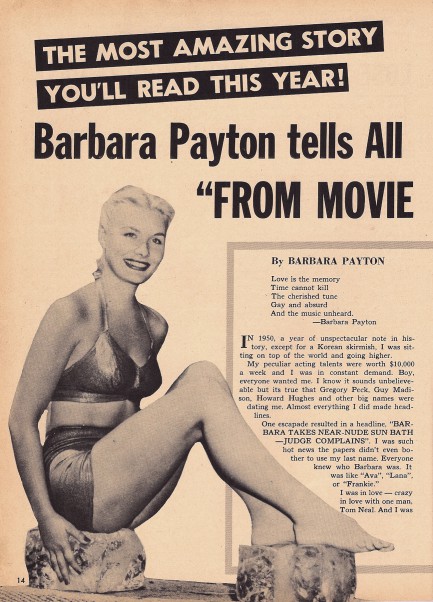 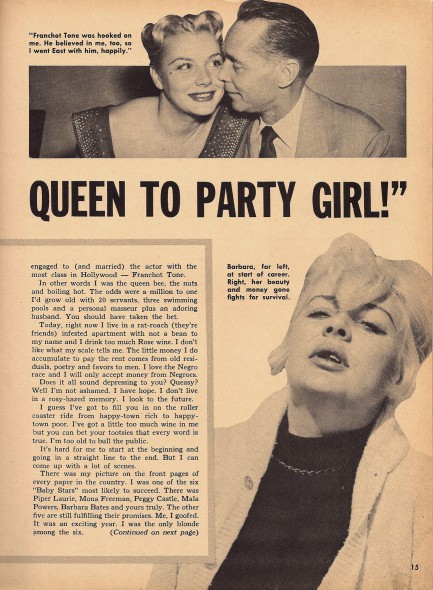 temperatures wherever I went. Today I have three long knife wounds on my solid frame. One extends from my buttocks down my thigh and needed I don’t remember how many stitches.” Payton’s anecdotes are cringe worthy, but they read like she’d gotten a grip on her life. No such luck. After four more long years of drugs, drink, and disaster she was found dead on her bathroom floor in 1967. temperatures wherever I went. Today I have three long knife wounds on my solid frame. One extends from my buttocks down my thigh and needed I don’t remember how many stitches.” Payton’s anecdotes are cringe worthy, but they read like she’d gotten a grip on her life. No such luck. After four more long years of drugs, drink, and disaster she was found dead on her bathroom floor in 1967. Payton post-mortems usually describe her problems as self-induced, but that’s simplistic. In the 1950s famous men did anything they wished, but women had to be careful not to be seen doing the same. Still do today. That’s the part Payton had problems with. Even so, she had several happy periods during her life. One of those was the stretch she spent in Mexico married to a young fisherman. About this time she says, “We fished and I caught big ones, and we loved and for a couple of years it was beautiful. My big problems were what to cook for dinner. But it was inevitable the ants in my pants would start crawling again.” 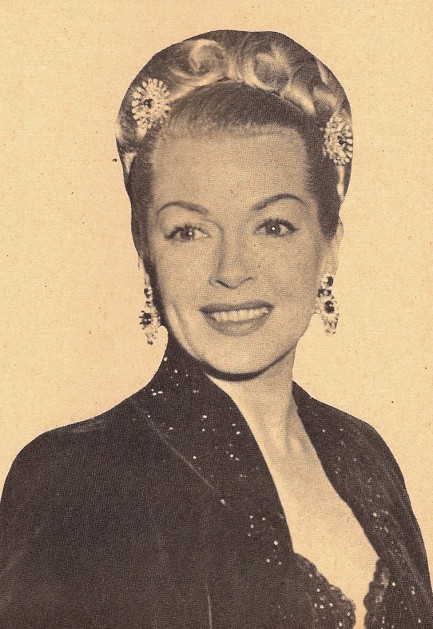 We like that passage, because nearly all the stories about Payton declare, or at least suggest, that everything that happened after Hollywood stardom was part of a terminal plummet. That’s pretty much the default setting in American journalism—anything other than wealth and fame is by definition failure. It’s an idiotic conceit, even a harmful one, and Payton reveals that in Mexico she landed someplace solid and safe, and got along fine without money or recognition. Two years of happiness is nothing to take lightly. But she just couldn’t sit still—not because of where she was, but because of who she was. We like that passage, because nearly all the stories about Payton declare, or at least suggest, that everything that happened after Hollywood stardom was part of a terminal plummet. That’s pretty much the default setting in American journalism—anything other than wealth and fame is by definition failure. It’s an idiotic conceit, even a harmful one, and Payton reveals that in Mexico she landed someplace solid and safe, and got along fine without money or recognition. Two years of happiness is nothing to take lightly. But she just couldn’t sit still—not because of where she was, but because of who she was. And the spiral continued—cheaper and cheaper forms of prostitution, physical confrontations that resulted in her getting some of her teeth knocked out, and more. In all of these tales there’s a recurrent theme of lowly types taking advantage of her, but we can’t help noting that she was paid a mere $1,000 for her autobiography, an absurdly deficient amount for a former top star with a crazy story to tell, which suggests to us that guys in office suites take as much advantage—or more—of a person’s hard luck as guys in alleys. We have some scans below, and Payton will undoubtedly appear here again.
 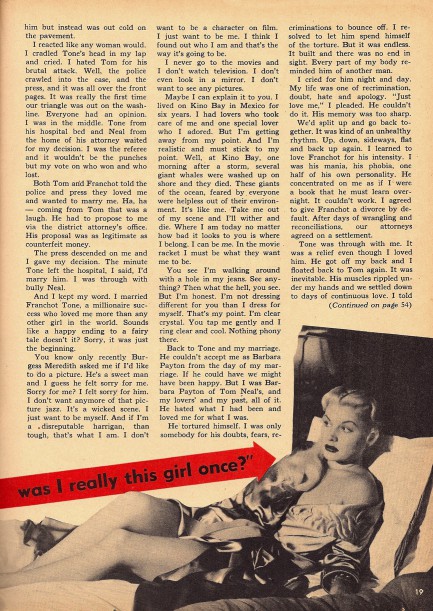 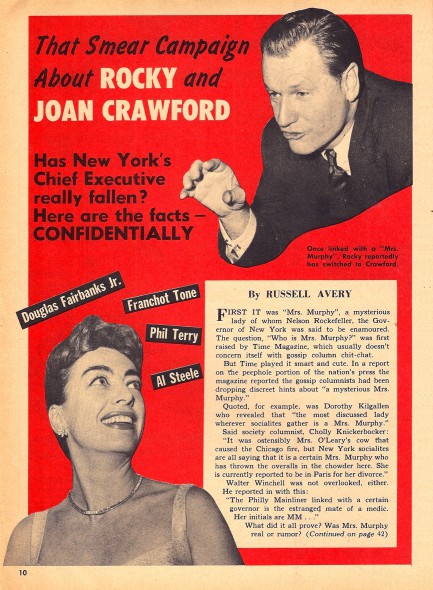 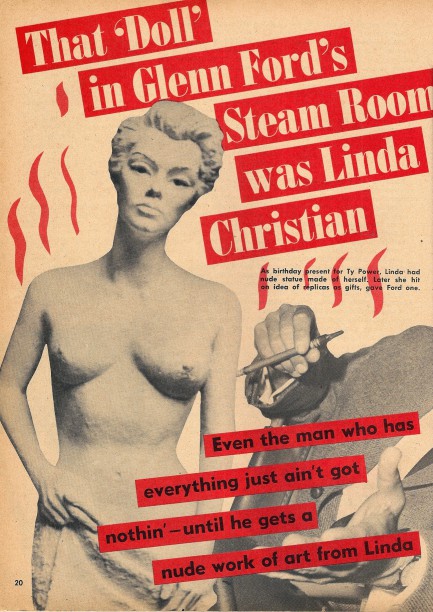 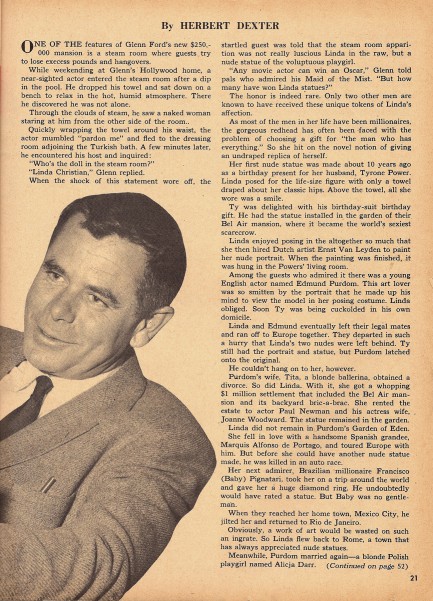 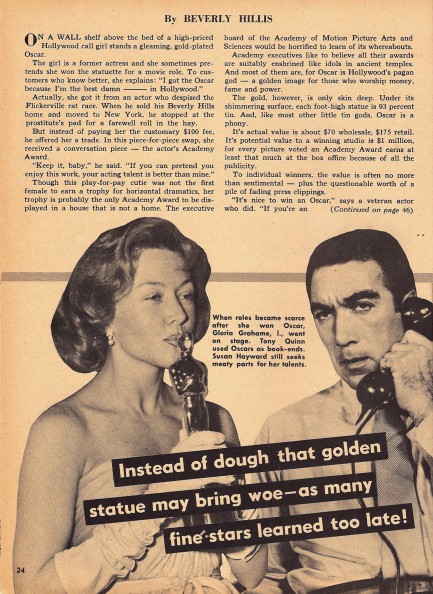 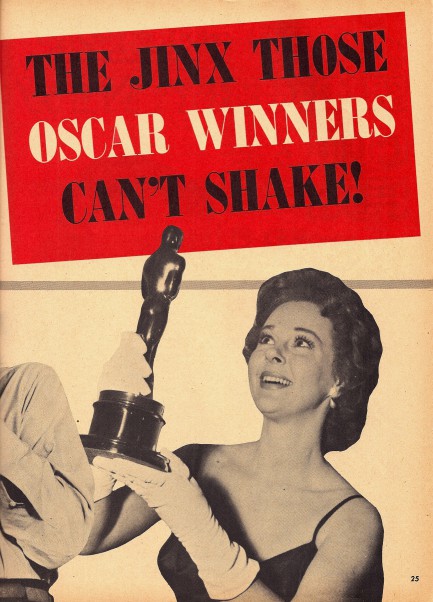 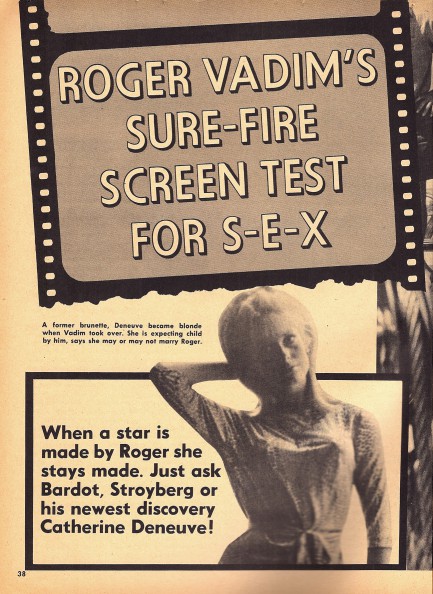 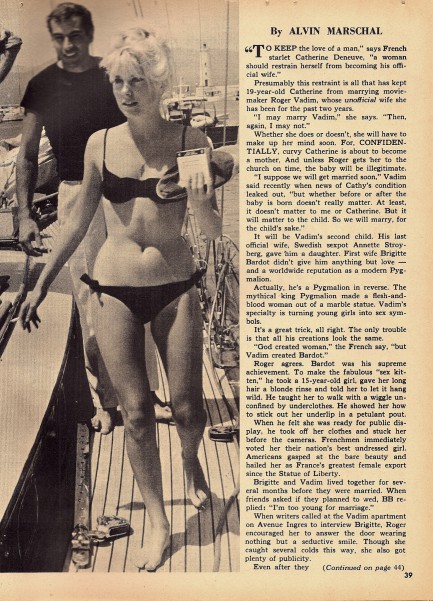 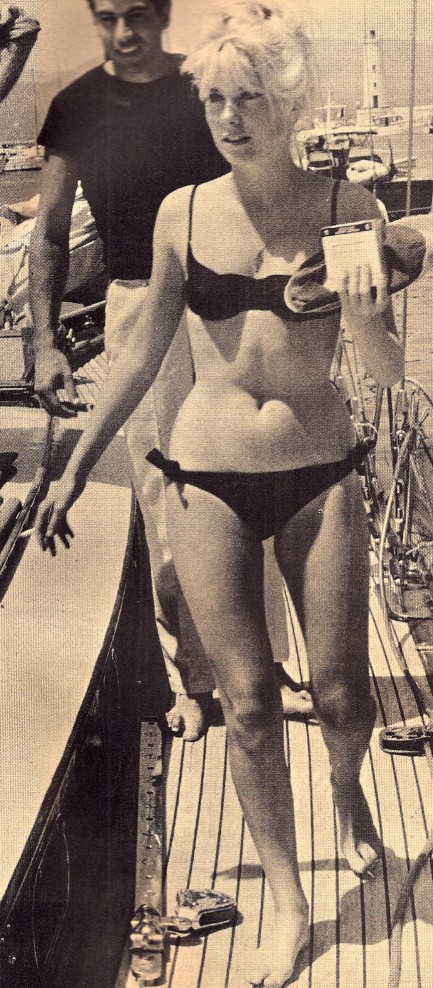 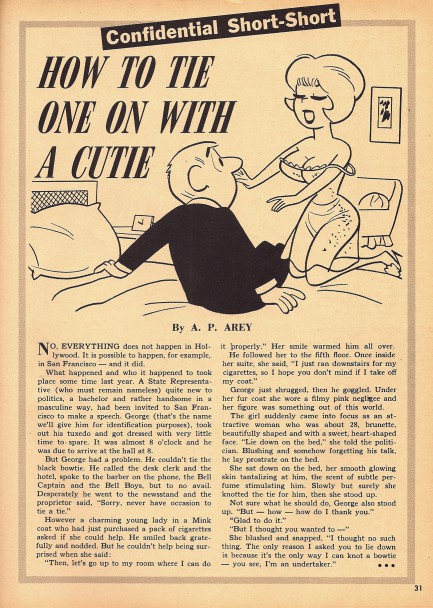
 Freak show on the dance floor. 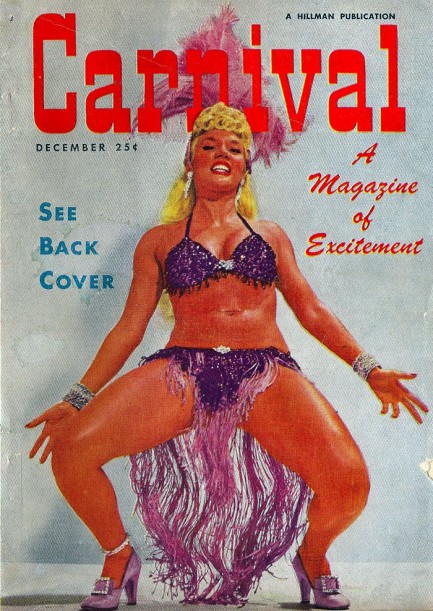
At the end of last month we posted a few images of Bettie Page that hadn’t appeared online before. They came from an issue of Carnival we were too lazy too scan in its entirety at the time. Today we have the rest of that great issue, vol. 1, no. 2, published out of Chicago, U.S.A. by Hillman Periodicals, who were the same people behind the magazine Show. The cover star is burlesque queen Lilly Christine, aka The Cat Girl, and she reappears in all her wild-eyed glory in a photo set we've placed at the very bottom of this post. We’ve seen at least two of those photos before in other magazines, however Carnival claims it was an exclusive set, shot especially for them, and indeed, that could be true, since theirs appeared before the others we saw. After a peek behind the scenes of the Miss Universe pageant, readers get a profile of Ernest Hemingway’s most recent trip to Spain. Hemingway was visiting the Festival of San Fermin in the Basque Country town of Pamplona in order to see how his favorite sport of bullfighting had fared in the years since he’d last visited. Since the text in these digest-sized magazines scans large enough to be legible, you can read what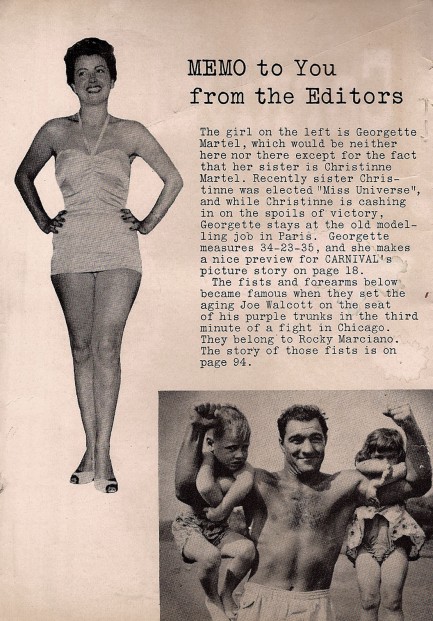 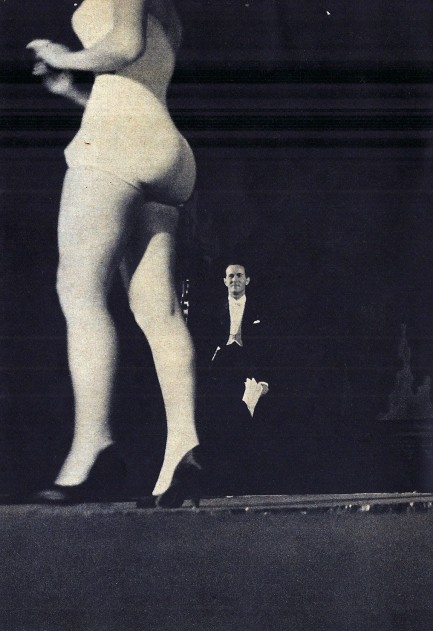 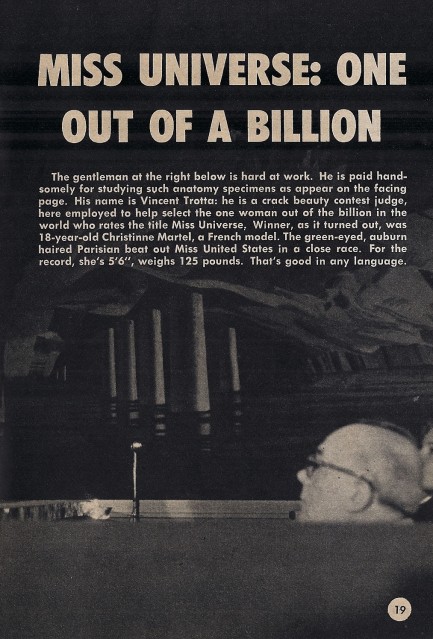 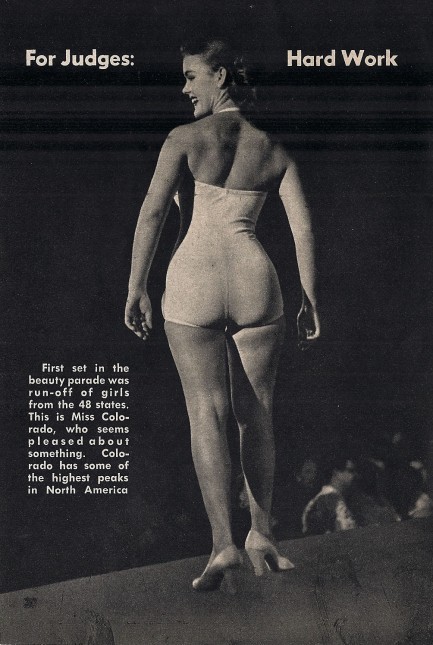 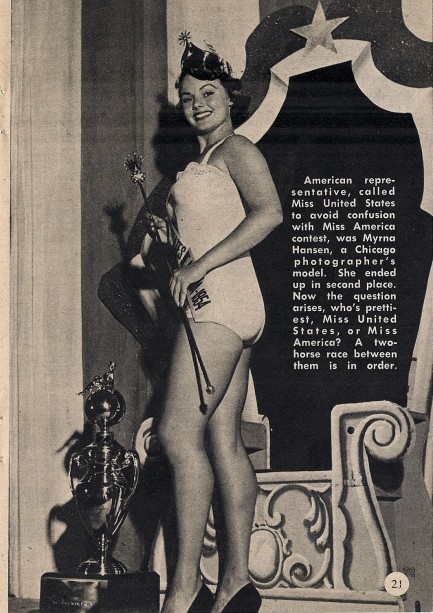 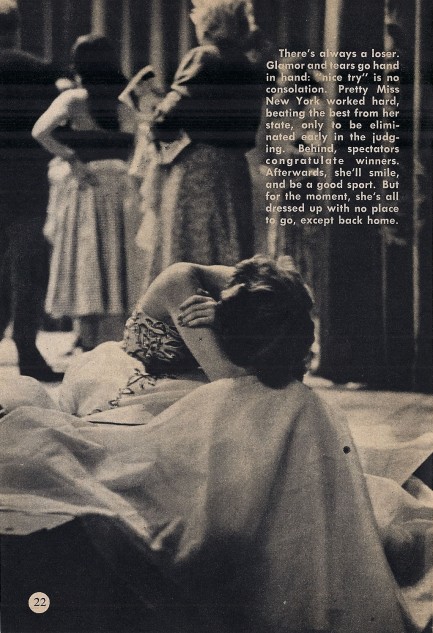 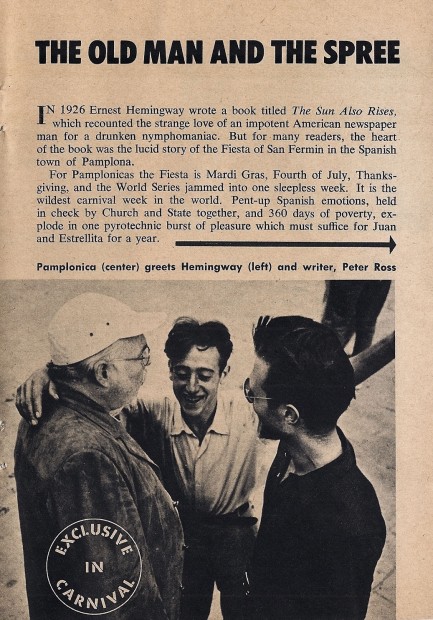 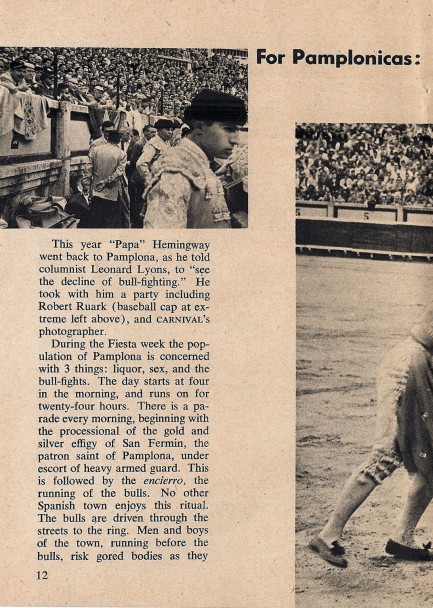 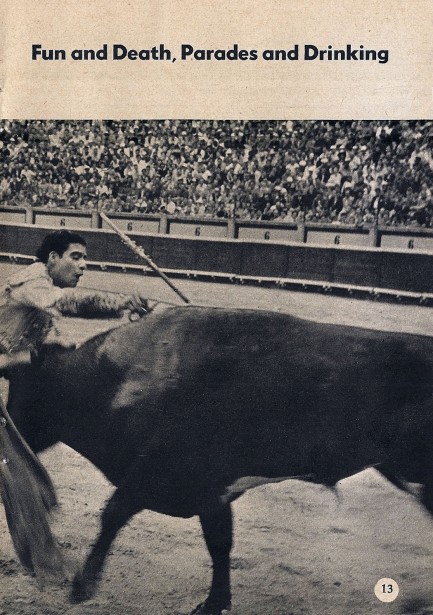 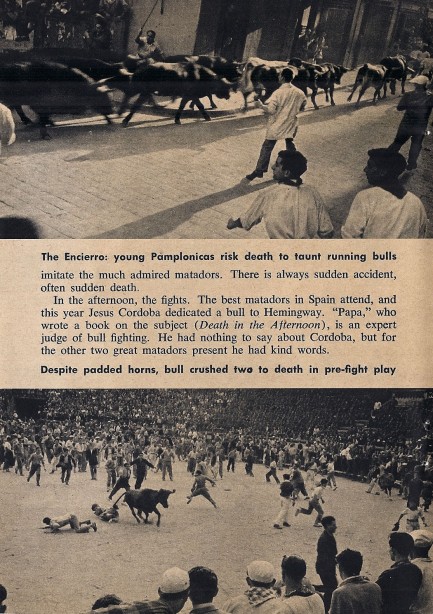 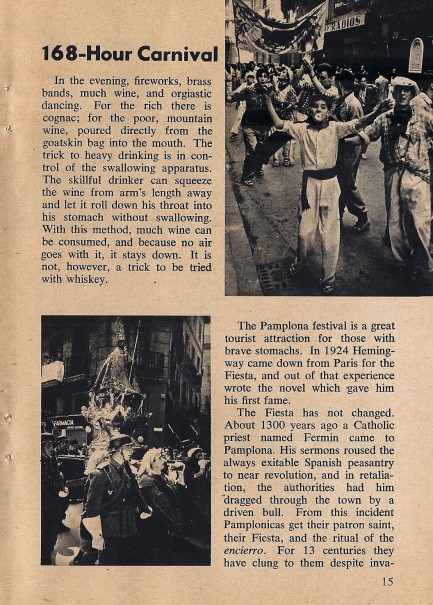 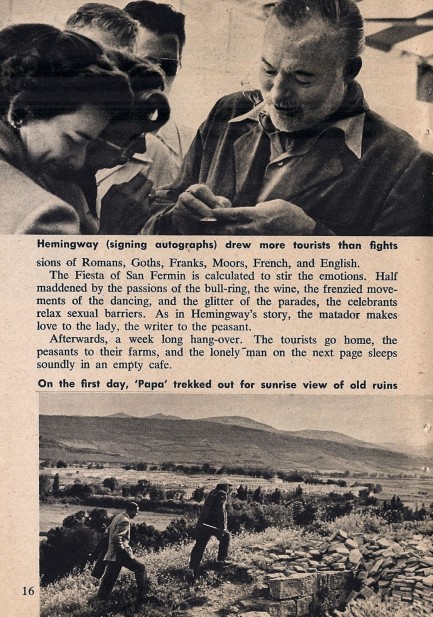 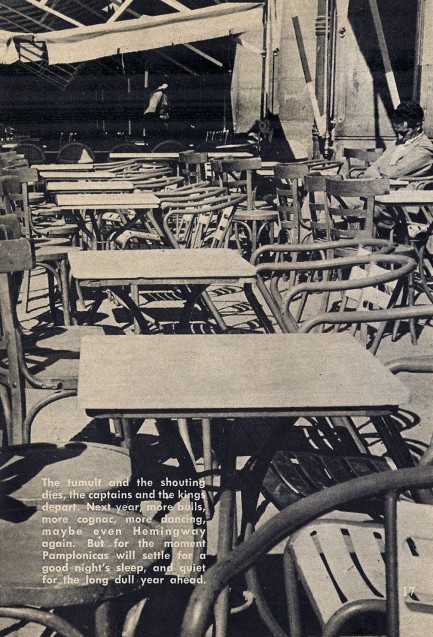 Carnival says about the famed festival yourself. We will note, however, that the writer’s description of Pamplona as dull when San Fermin isn’t happening is wrong. Spain in general, and the Basque Country in particular, are never dull. Trust us—we’ve spent a lot of time there. If you’re interested, you can read our firsthand observations of San Fermin here and here. Carnival says about the famed festival yourself. We will note, however, that the writer’s description of Pamplona as dull when San Fermin isn’t happening is wrong. Spain in general, and the Basque Country in particular, are never dull. Trust us—we’ve spent a lot of time there. If you’re interested, you can read our firsthand observations of San Fermin here and here. Carnival next presents readers with photos of dancer Nejla Ates, whose short set begins just below. We first saw one of these shots in an issue of Uncensored dating from June 1954, but once again Carnival seems to have gotten there first—their photos are from 1953. Ates, who for some reason often appears online unidentified, was Romanian born of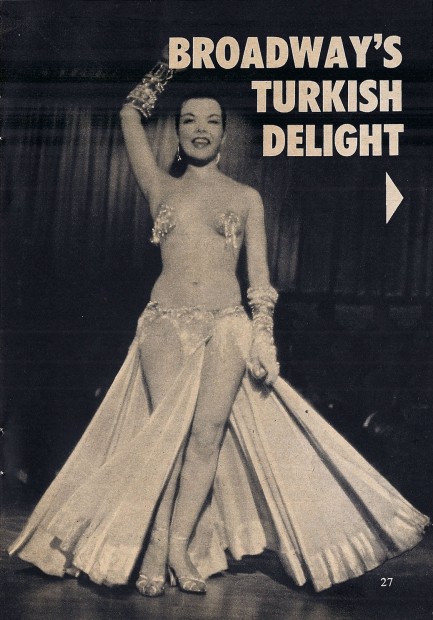 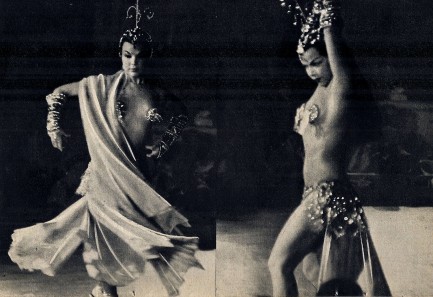 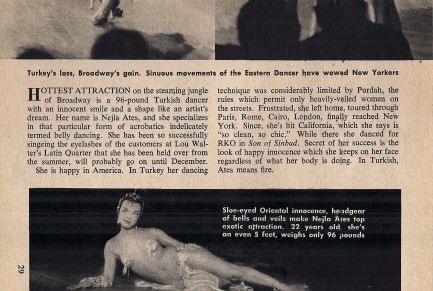 Tatar descent, and danced her way through Cairo, Rome, Paris, and London, before finally gaining international fame in New York City. She appeared in three American films during the 1950s, and was the go-to cover model for Middle-Eastern and bellydancing themed album sleeves, but despite her successes suffered the usual slate of dead end affairs and romantic heartbreaks with such men as, among others, Billy Daniels, George Sanders, and Gary Crosby. Tatar descent, and danced her way through Cairo, Rome, Paris, and London, before finally gaining international fame in New York City. She appeared in three American films during the 1950s, and was the go-to cover model for Middle-Eastern and bellydancing themed album sleeves, but despite her successes suffered the usual slate of dead end affairs and romantic heartbreaks with such men as, among others, Billy Daniels, George Sanders, and Gary Crosby. Following Ates is a photo feature on American actress and party girl Barbara Payton, who burned a swath through Hollywood during the 1950s, bedding co-stars, feuding with her studio, and generally raising a ruckus before eventually drifting into prostitution and dying at 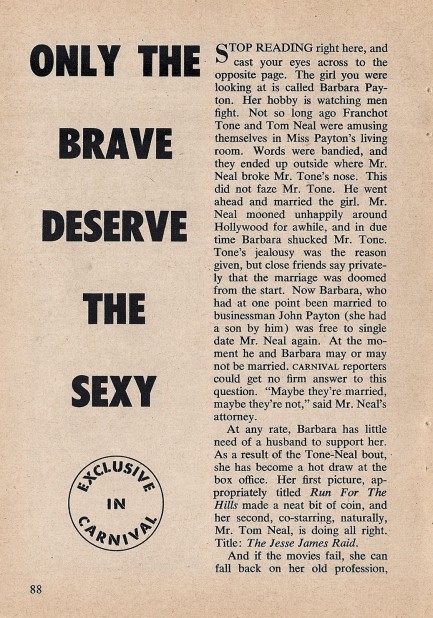 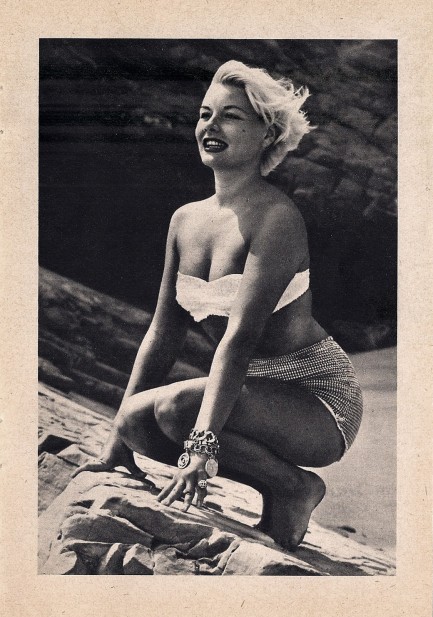 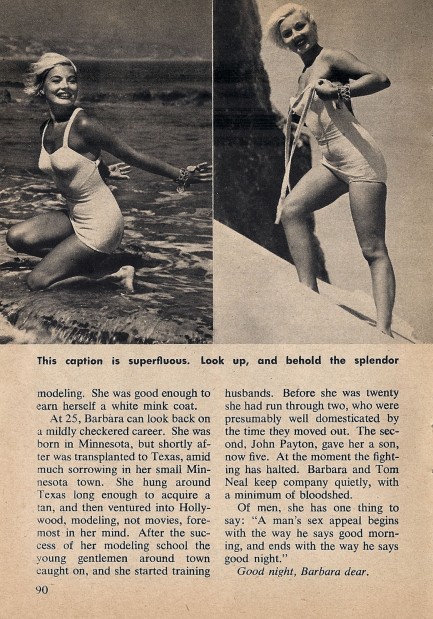 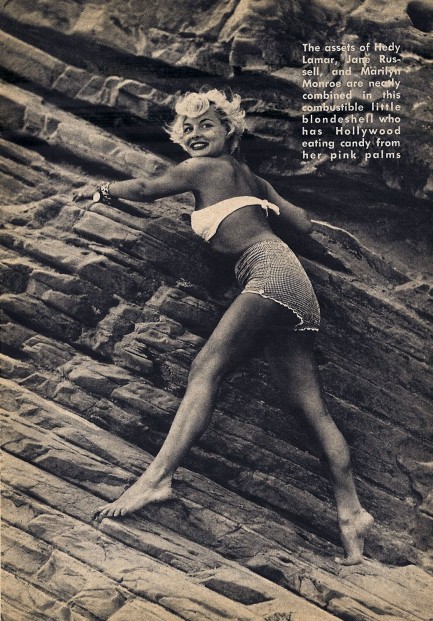 age thirty-nine of heart and liver failure. She’s described here as possessing the “assets of Hedy Lamarr, Jane Russell and Marilyn Monroe” all at once. Not sure about that, but we'll be finding out more about her later, because we will be examining her very pulpish life story in detail. age thirty-nine of heart and liver failure. She’s described here as possessing the “assets of Hedy Lamarr, Jane Russell and Marilyn Monroe” all at once. Not sure about that, but we'll be finding out more about her later, because we will be examining her very pulpish life story in detail. Next you get a great close-up photo of Jersey Joe Walcott having a disagreement with Rocky Marciano’s fist. Does that shot also look familiar? Perhaps because it was the cover of a January 1953 National Police Gazette. We had no idea that the fight was considered controversial at the time. Apparently, many thought Walcott took a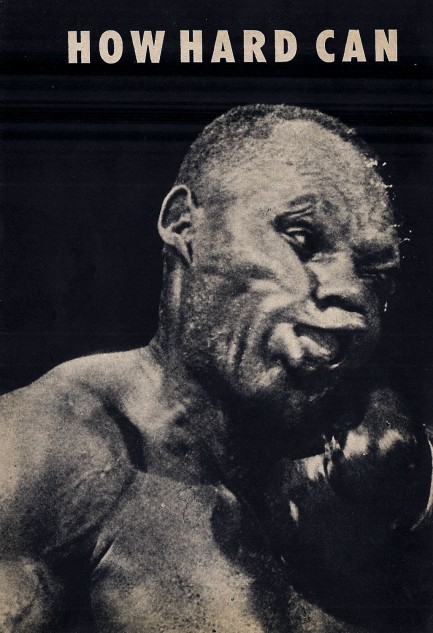 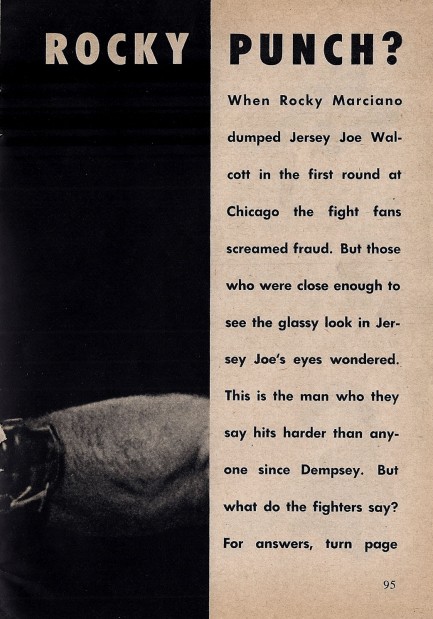 dive. Since this photo is of the actual the shot that sent Walcott to the canvas, we have to respectfully disagree. It’s lights out, and anyone can see that. In any case, you can take a gander at that Gazette cover and learn a bit about Marciano and Walcott here. dive. Since this photo is of the actual the shot that sent Walcott to the canvas, we have to respectfully disagree. It’s lights out, and anyone can see that. In any case, you can take a gander at that Gazette cover and learn a bit about Marciano and Walcott here. A few more treats: panel 24, just below, contains a hot shot of Marilyn Monroe at a charity baseball game; panel 26 features actress Sheree North, who doesn’t look very impressive, which means you should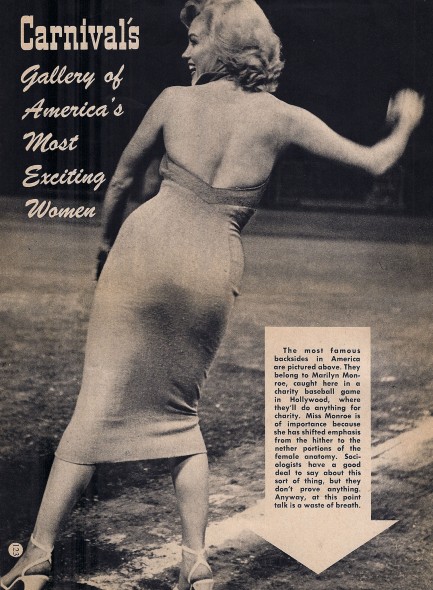 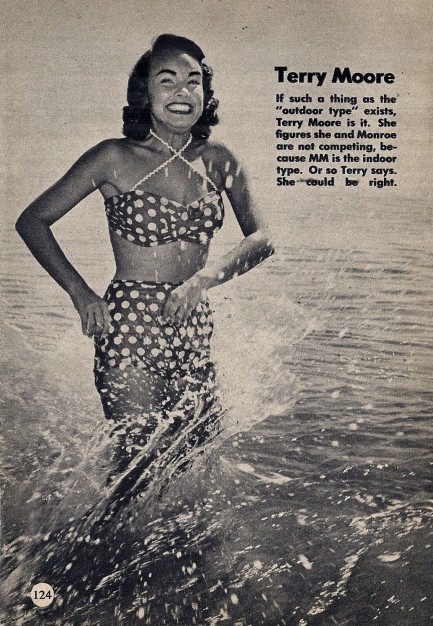 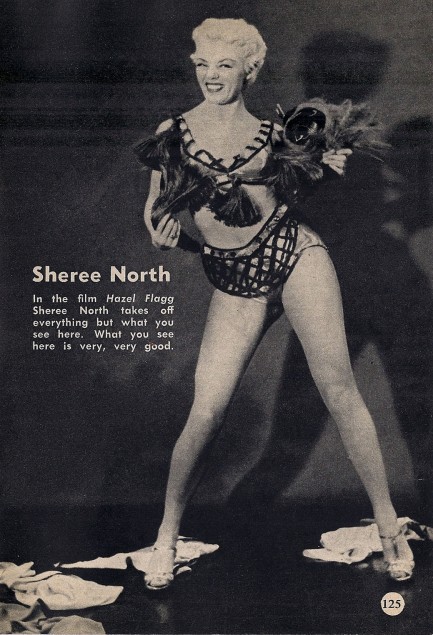 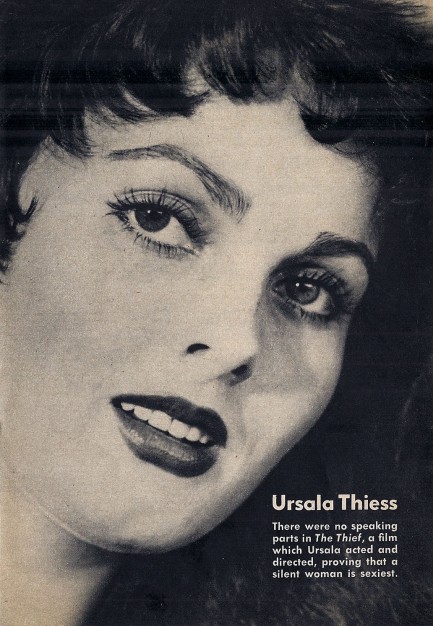 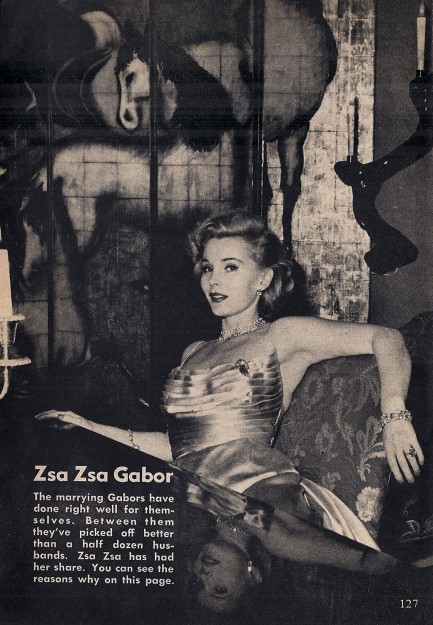 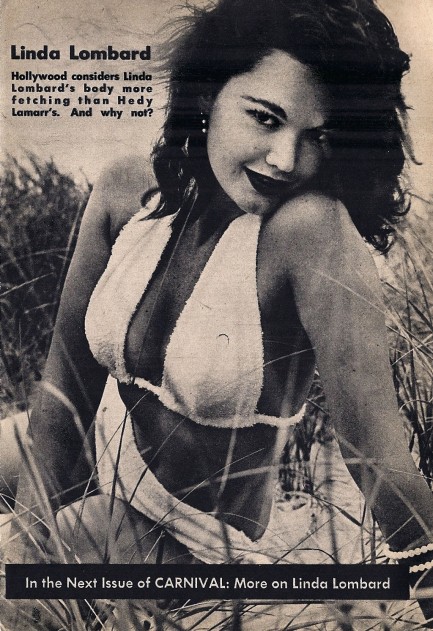 click over to our lovely femme fatale post on her here and get a sense of what a knockout she really was; and lastly, in panel 28, above, you get a killer shot of Zsa Zsa Gabor, who, believe it or not, was already nearly forty at the time and had been married three times on the way to her final tally of nine. click over to our lovely femme fatale post on her here and get a sense of what a knockout she really was; and lastly, in panel 28, above, you get a killer shot of Zsa Zsa Gabor, who, believe it or not, was already nearly forty at the time and had been married three times on the way to her final tally of nine. Looking at all these pages and visiting the accompanying links, you perhaps get a sense of how the mid-century tabloid industry was fueled by handout photos, with all the publications using the same shots but concocting editorial angles to create the illusion that the images were exclusive. But in Carnival’s case, it does seem to have published many of these images first. It billed itself as “a magazine of excitement”, and we have to agree. It’s also a magazine that, because of its tightly bound construction, we had to destroy in order to scan. But even though this particular issue of Carnival is now only loose leaves scattered across the room, there are other issues out there, and we’ll have some of them later, hopefully. 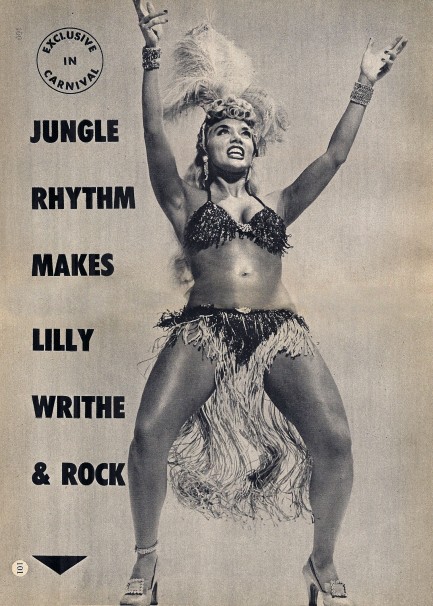 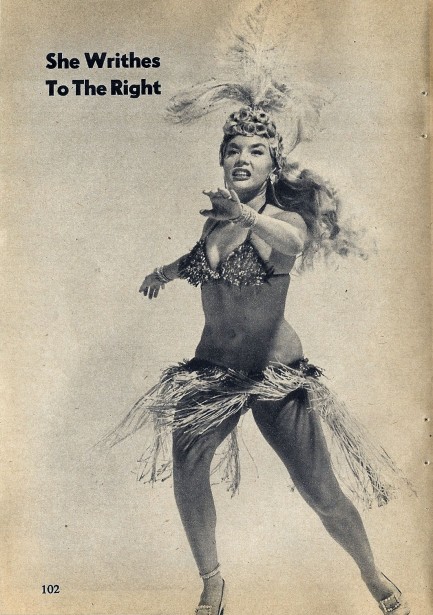 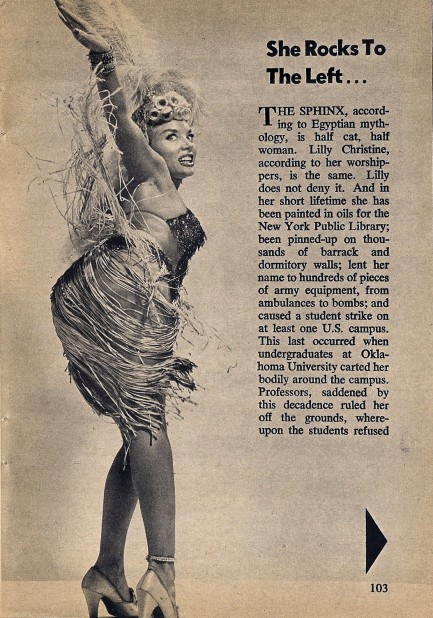 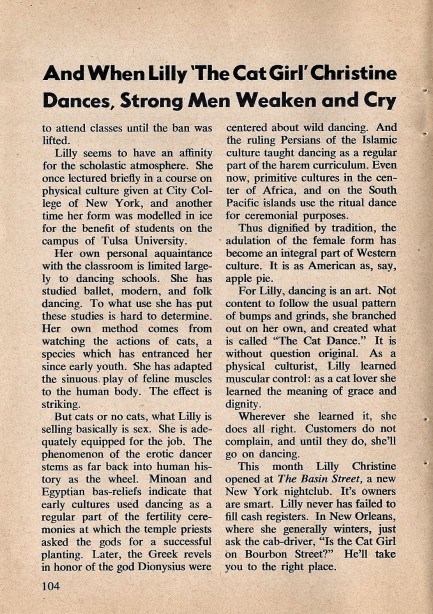 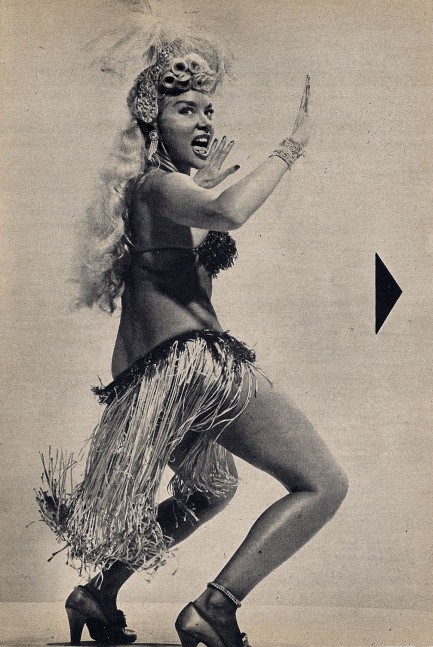 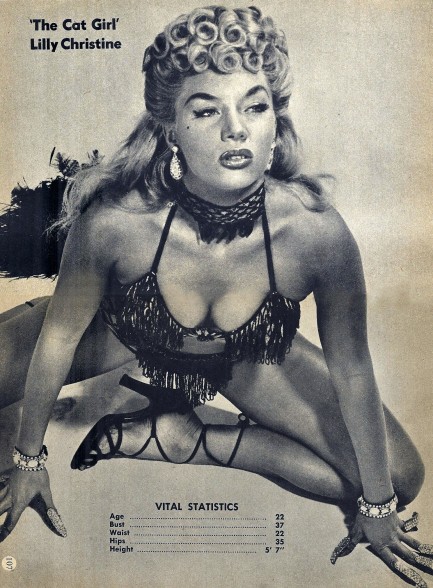
|
 |

The headlines that mattered yesteryear.
1945—Churchill Given the Sack
In spite of admiring Winston Churchill as a great wartime leader, Britons elect
Clement Attlee the nation's new prime minister in a sweeping victory for the Labour Party over the Conservatives. 1952—Evita Peron Dies
Eva Duarte de Peron, aka Evita, wife of the president of the Argentine Republic, dies from cancer at age 33. Evita had brought the working classes into a position of political power never witnessed before, but was hated by the nation's powerful military class. She is lain to rest in Milan, Italy in a secret grave under a nun's name, but is eventually returned to Argentina for reburial beside her husband in 1974. 1943—Mussolini Calls It Quits
Italian dictator Benito Mussolini steps down as head of the armed forces and the government. It soon becomes clear that Il Duce did not relinquish power voluntarily, but was forced to resign after former Fascist colleagues turned against him. He is later installed by Germany as leader of the Italian Social Republic in the north of the country, but is killed by partisans in 1945. 1915—Ship Capsizes on Lake Michigan
During an outing arranged by Western Electric Co. for its employees and their families, the passenger ship Eastland capsizes in Lake Michigan due to unequal weight distribution. 844 people die, including all the members of 22 different families. 1980—Peter Sellers Dies
British movie star Peter Sellers, whose roles in Dr. Strangelove, Being There and the Pink Panther films established him as the greatest comedic actor of his generation, dies of a heart attack at age fifty-four.
|

|
|

It's easy. We have an uploader that makes it a snap. Use it to submit your art, text, header, and subhead. Your post can be funny, serious, or anything in between, as long as it's vintage pulp. You'll get a byline and experience the fleeting pride of free authorship. We'll edit your post for typos, but the rest is up to you. Click here to give us your best shot.

|
|














 Show business careers go off the rails for a wide array of reasons—lack of talent, lack of audience appeal, substance abuse, and a predilection for general mayhem all come to mind. Hollywood actor Tom Neal fits legendarily into the last category. From his debut in 1938 through 1951 he logged more than seventy film appearances. That's incredible output by any measure. Most of his roles were in b-movies, but there were some notable parts mixed in. His career highlights included Another Thin Man, the film noir Detour, and Crime, Inc.
Show business careers go off the rails for a wide array of reasons—lack of talent, lack of audience appeal, substance abuse, and a predilection for general mayhem all come to mind. Hollywood actor Tom Neal fits legendarily into the last category. From his debut in 1938 through 1951 he logged more than seventy film appearances. That's incredible output by any measure. Most of his roles were in b-movies, but there were some notable parts mixed in. His career highlights included Another Thin Man, the film noir Detour, and Crime, Inc. record in the ring. Maybe Tone slipped on a dollop of Beluga caviar. Payton said Tone simply had no choice about fighting because Neal attacked him. Whatever the reason, Neal floored Tone with his first punch, and continued to beat him afterward, delivering cheek and nose fractures. Tone lay in an eighteen hour coma in the hospital. Ironically, that was the day Payton's divorce had come through.
record in the ring. Maybe Tone slipped on a dollop of Beluga caviar. Payton said Tone simply had no choice about fighting because Neal attacked him. Whatever the reason, Neal floored Tone with his first punch, and continued to beat him afterward, delivering cheek and nose fractures. Tone lay in an eighteen hour coma in the hospital. Ironically, that was the day Payton's divorce had come through.
 soon discovered that Payton—wait for it—had never stopped seeing Neal, including while Tone was in the hospital with a broken face. So there went that marriage. It seemed as if Neal had unequivocally won Payton's affections after all, and she does look happy in the 1952 photo above, but it's probably no surprise to learn that the two parted ways after a few tumultuous years, some broken windows, and at least one police intervention. Payton went on to have truly epic problems that would put a South American novela to shame.
soon discovered that Payton—wait for it—had never stopped seeing Neal, including while Tone was in the hospital with a broken face. So there went that marriage. It seemed as if Neal had unequivocally won Payton's affections after all, and she does look happy in the 1952 photo above, but it's probably no surprise to learn that the two parted ways after a few tumultuous years, some broken windows, and at least one police intervention. Payton went on to have truly epic problems that would put a South American novela to shame.
 slug entering her skull behind her right ear and ending up in a sofa cushion. Neal wasn't on the premises when police arrived, but was soon arrested, and claimed the shooting had been an accident, the result of a struggle over the gun after his wife pulled it on him.
slug entering her skull behind her right ear and ending up in a sofa cushion. Neal wasn't on the premises when police arrived, but was soon arrested, and claimed the shooting had been an accident, the result of a struggle over the gun after his wife pulled it on him.


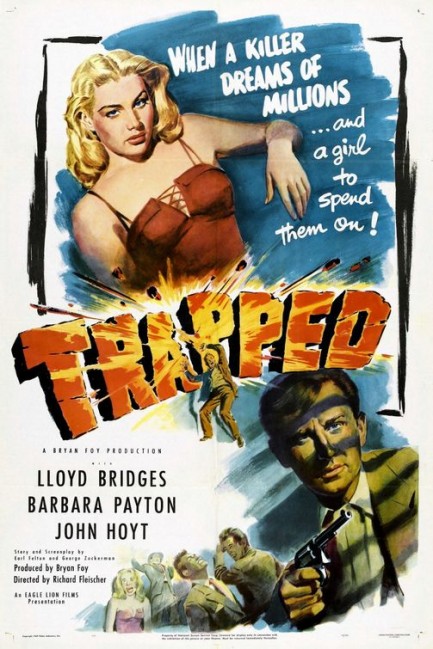
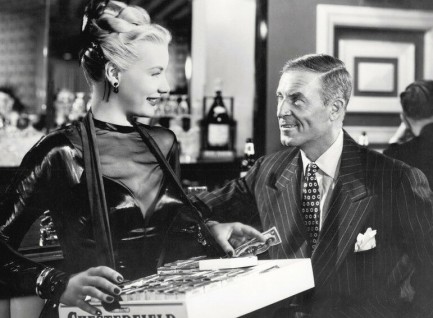
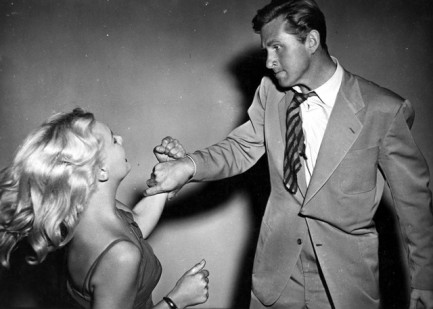
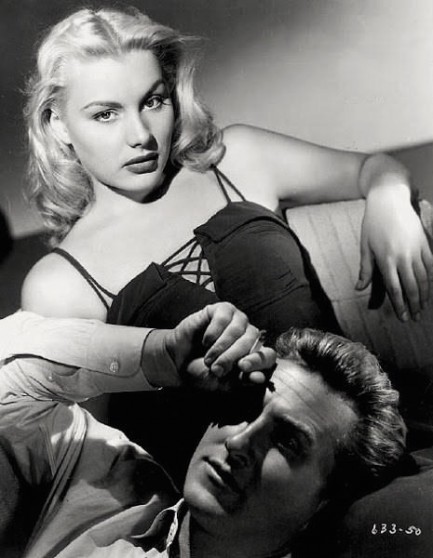
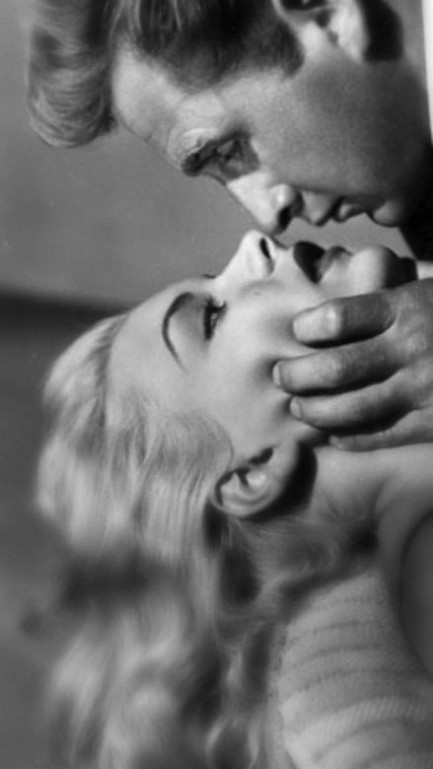





 for a while Payton was the top call girl in town, and added this tidbit: “I have to say that a half hour with her was like two hours with someone else. She was electrifyingly sexy and made a man feel totally and wholly satisfied.”
for a while Payton was the top call girl in town, and added this tidbit: “I have to say that a half hour with her was like two hours with someone else. She was electrifyingly sexy and made a man feel totally and wholly satisfied.”





















 entitled "An Interlude Before Evening," and involved being helped from her clothing by her maid Sadie before slipping nude into a bathtub. But the nudity was an illusion, the cleverest part of her act, achieved through a combination of lighting, positioning, flesh-colored underwear, and sheer athleticism as she slipped quickly from behind a towel and into the sudsy tub.
entitled "An Interlude Before Evening," and involved being helped from her clothing by her maid Sadie before slipping nude into a bathtub. But the nudity was an illusion, the cleverest part of her act, achieved through a combination of lighting, positioning, flesh-colored underwear, and sheer athleticism as she slipped quickly from behind a towel and into the sudsy tub. The trial was scheduled for early December in the Beverly Hills Courthouse. Giesler kept the jury—which wasn’t all strippers, but at least was mostly female—laughing with his continual antics. He introduced St. Cyr’s rhinestone encrusted bra and g-string as people’s exhibits A and B. He drew diagrams on a blackboard illustrating how different observers' vantage points toward the stage were blocked by St. Cyr's maid. He flustered police officials by making them discuss in detail such such terms as “bump,” “grind,” and “half-bump,” and followed that up by putting Herman Hover on the witness stand and having him demonstrate those moves. The sight of the portly Hover attempting burlesque sent ripples of laughter through the courtroom. Years later Giesler wrote: “I can honestly say I succeeded in having her case laughed into a not-guilty verdict.”
The trial was scheduled for early December in the Beverly Hills Courthouse. Giesler kept the jury—which wasn’t all strippers, but at least was mostly female—laughing with his continual antics. He introduced St. Cyr’s rhinestone encrusted bra and g-string as people’s exhibits A and B. He drew diagrams on a blackboard illustrating how different observers' vantage points toward the stage were blocked by St. Cyr's maid. He flustered police officials by making them discuss in detail such such terms as “bump,” “grind,” and “half-bump,” and followed that up by putting Herman Hover on the witness stand and having him demonstrate those moves. The sight of the portly Hover attempting burlesque sent ripples of laughter through the courtroom. Years later Giesler wrote: “I can honestly say I succeeded in having her case laughed into a not-guilty verdict.” 
 see the outline of her “private parts,” which he discerned in enough detail to determine “were shaven.” The inconsistencies were epic. Some said she caressed herself, others weren’t sure. Another described her towel as “about twenty, twenty-four inches.” In reality it was three times that size. It was as if St. Cyr's dance had dumbfounded the cops.
see the outline of her “private parts,” which he discerned in enough detail to determine “were shaven.” The inconsistencies were epic. Some said she caressed herself, others weren’t sure. Another described her towel as “about twenty, twenty-four inches.” In reality it was three times that size. It was as if St. Cyr's dance had dumbfounded the cops.
 freed her to inhabit different characters. Despite her assertions that she always wore at least a g-string and bra, she definitely performed topless on occasion, as shown by the above photo taken at Ciro’s during early 1951.
freed her to inhabit different characters. Despite her assertions that she always wore at least a g-string and bra, she definitely performed topless on occasion, as shown by the above photo taken at Ciro’s during early 1951.


 temperatures wherever I went. Today I have three long knife wounds on my solid frame. One extends from my buttocks down my thigh and needed I don’t remember how many stitches.” Payton’s anecdotes are cringe worthy, but they read like she’d gotten a grip on her life. No such luck. After four more long years of drugs, drink, and disaster she was found dead on her bathroom floor in 1967.
temperatures wherever I went. Today I have three long knife wounds on my solid frame. One extends from my buttocks down my thigh and needed I don’t remember how many stitches.” Payton’s anecdotes are cringe worthy, but they read like she’d gotten a grip on her life. No such luck. After four more long years of drugs, drink, and disaster she was found dead on her bathroom floor in 1967. We like that passage, because nearly all the stories about Payton declare, or at least suggest, that everything that happened after Hollywood stardom was part of a terminal plummet. That’s pretty much the default setting in American journalism—anything other than wealth and fame is by definition failure. It’s an idiotic conceit, even a harmful one, and Payton reveals that in Mexico she landed someplace solid and safe, and got along fine without money or recognition. Two years of happiness is nothing to take lightly. But she just couldn’t sit still—not because of where she was, but because of who she was.
We like that passage, because nearly all the stories about Payton declare, or at least suggest, that everything that happened after Hollywood stardom was part of a terminal plummet. That’s pretty much the default setting in American journalism—anything other than wealth and fame is by definition failure. It’s an idiotic conceit, even a harmful one, and Payton reveals that in Mexico she landed someplace solid and safe, and got along fine without money or recognition. Two years of happiness is nothing to take lightly. But she just couldn’t sit still—not because of where she was, but because of who she was.
























 Carnival says about the famed festival yourself. We will note, however, that the writer’s description of Pamplona as dull when San Fermin isn’t happening is wrong. Spain in general, and the Basque Country in particular, are never dull. Trust us—we’ve spent a lot of time there. If you’re interested, you can read our firsthand observations of San Fermin here and here.
Carnival says about the famed festival yourself. We will note, however, that the writer’s description of Pamplona as dull when San Fermin isn’t happening is wrong. Spain in general, and the Basque Country in particular, are never dull. Trust us—we’ve spent a lot of time there. If you’re interested, you can read our firsthand observations of San Fermin here and here.

 Tatar descent, and danced her way through Cairo, Rome, Paris, and London, before finally gaining international fame in New York City. She appeared in three American films during the 1950s, and was the go-to cover model for Middle-Eastern and bellydancing themed album sleeves, but despite her successes suffered the usual slate of dead end affairs and romantic heartbreaks with such men as, among others, Billy Daniels, George Sanders, and Gary Crosby.
Tatar descent, and danced her way through Cairo, Rome, Paris, and London, before finally gaining international fame in New York City. She appeared in three American films during the 1950s, and was the go-to cover model for Middle-Eastern and bellydancing themed album sleeves, but despite her successes suffered the usual slate of dead end affairs and romantic heartbreaks with such men as, among others, Billy Daniels, George Sanders, and Gary Crosby.


 age thirty-nine of heart and liver failure. She’s described here as possessing the “assets of Hedy Lamarr, Jane Russell and Marilyn Monroe” all at once. Not sure about that, but we'll be finding out more about her later, because we will be examining her very pulpish life story in detail.
age thirty-nine of heart and liver failure. She’s described here as possessing the “assets of Hedy Lamarr, Jane Russell and Marilyn Monroe” all at once. Not sure about that, but we'll be finding out more about her later, because we will be examining her very pulpish life story in detail.
 dive. Since this photo is of the actual the shot that sent Walcott to the canvas, we have to respectfully disagree. It’s lights out, and anyone can see that. In any case, you can take a gander at that Gazette cover and learn a bit about Marciano and Walcott here.
dive. Since this photo is of the actual the shot that sent Walcott to the canvas, we have to respectfully disagree. It’s lights out, and anyone can see that. In any case, you can take a gander at that Gazette cover and learn a bit about Marciano and Walcott here.




 click over to our lovely femme fatale post on her here and get a sense of what a knockout she really was; and lastly, in panel 28, above, you get a killer shot of Zsa Zsa Gabor, who, believe it or not, was already nearly forty at the time and had been married three times on the way to her final tally of nine.
click over to our lovely femme fatale post on her here and get a sense of what a knockout she really was; and lastly, in panel 28, above, you get a killer shot of Zsa Zsa Gabor, who, believe it or not, was already nearly forty at the time and had been married three times on the way to her final tally of nine.









































































